  Invited Seminar Invited Seminar  |
| |
現在、セミナーは 九州大学 大学院薬学研究院 生理学分野 にて実施
|
| |
| |
| 2020 |
Date: 2020/1/22 PM6:00~
Speaker:西村 明幸 先生 (九州大学大学院薬学研究院創薬育薬研究施設統括室)
Title:活性イオウによる心筋ミトコンドリア品質制御と心臓恒常性維持・変容機構の解明
病的な心臓リモデリングの進行に伴う心筋細胞の早期老化は心機能低下の主要な要因である。私たちは、ミトコンドリア分裂因子Drp1の活性化を介したミトコンドリアの過分裂が心筋早期老化の引き金となることを見出した。Drp1の新規活性化因子としてアクチン結合蛋白質Filamin
Aを同定し、疾患特異的なDrp1-Filamin A複合体形成が心筋早期老化を誘導すること、薬理的にこの複合体形成を阻害することで心不全の進行を抑制できることを明らかにした。また、活性イオウによるDrp1の硫黄付加(ポリイオウ化)修飾がFilamin
Aとの複合体形成を制御すること、Drp1のポリイオウ化状態が心疾患リスクに関与することを見出した。本セミナーでは、心臓の恒常性における活性イオウを介した心筋ミトコンドリア品質制御の重要性について紹介する。 |
|
|
| |
2019
|
Date: 2019/12/4 PM1:00~2:30
Speaker:Ken Suzuki, Professor (Translational Cardiovascular Therapeutics, William Harvey Research Institute,
Barts and The London School of Medicine and Dentistry, Queen Mary University
of London, UK)
Title:多様なるマクロファージ;新たな治療法の開発に向けて
近年マクロファージに関する理解が大きく進展しています。特に組織修復能を持つマクロファージが臓器特異的に在住あるいは集積し、様々な疾患の病因及び治癒において主要な役割を果たすことが明らかになり、これらの知見が新たな治療法開発につながることが期待されています。我々の研究室でもこの細胞を応用した心不全に対する新規治療法、さらに術後癒着予防療法を検討してきましたので、本セミナーではその試みについて紹介致します。
|
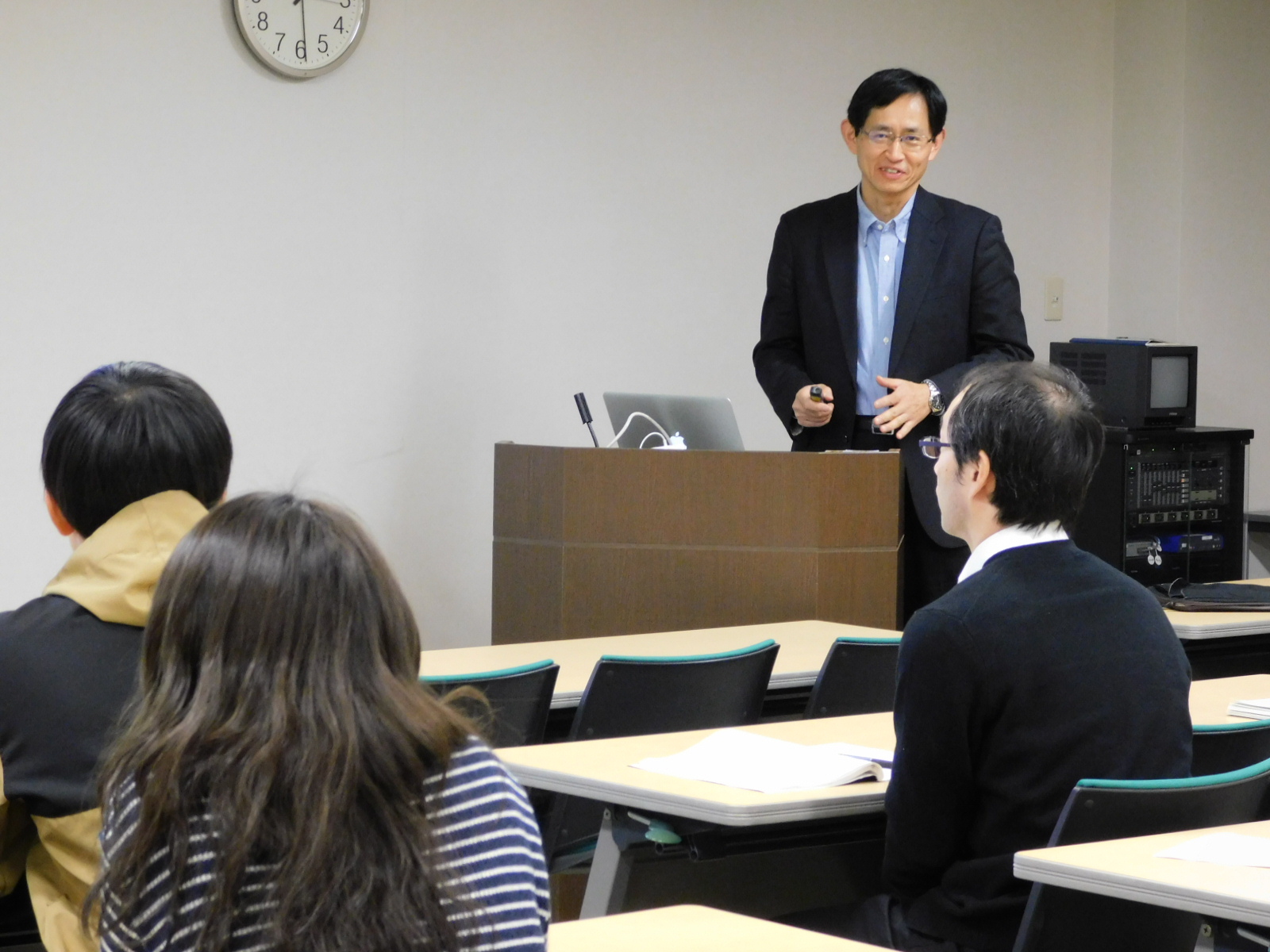 |
Date: 2019/9/12 PM4:00~5:30
Speaker:Professor Philip Eaton(William Harvey Research Institute, Queen Mary University of London)
Title:Redox sensing and signalling in the cardiovascular system
Oxidants, which can be produced in cells and tissues, have been causatively
implicated in the pathogenesis of most major diseases. Whilst this paradigm
is still prevalent, and oxidants may indeed play important roles in the
disease etiology, it is now also understood that they can also serve as
regulatory entities that are important for the maintenance of homeostasis
during health and disease. Oxidants can be sensed and transduced into a
biological event via their reaction with select cysteine thiol side chains
on some proteins. Such reactions can result in oxidative post-translational
modifications of proteins that in some cases alter their function to enable
adaptation and homeostasis. Protein kinase A (PKA) and protein kinase G
(PKG) are cyclic nucleotide-dependent kinases, being activated by the second
messenger cAMP or cGMP respectively. The Regulatory RIasubunit of PKA and
the PKG Iaisoform are each able to form homo interprotein disulfides in
response to increased oxidants. These oxidative modifications alter the
function of PKA and PKG and have a complex interrelationship with their
cyclic nucleotide-dependent regulation. Comparing PKA C17S RIaor C42S PKG
Iatransgenic knock-in mice, engineered so that the they cannot form the
interprotein disulfides, to wild-type controls has allowed the importance
of these oxidative modifications to be defined in terms of cardiovascular
function. |
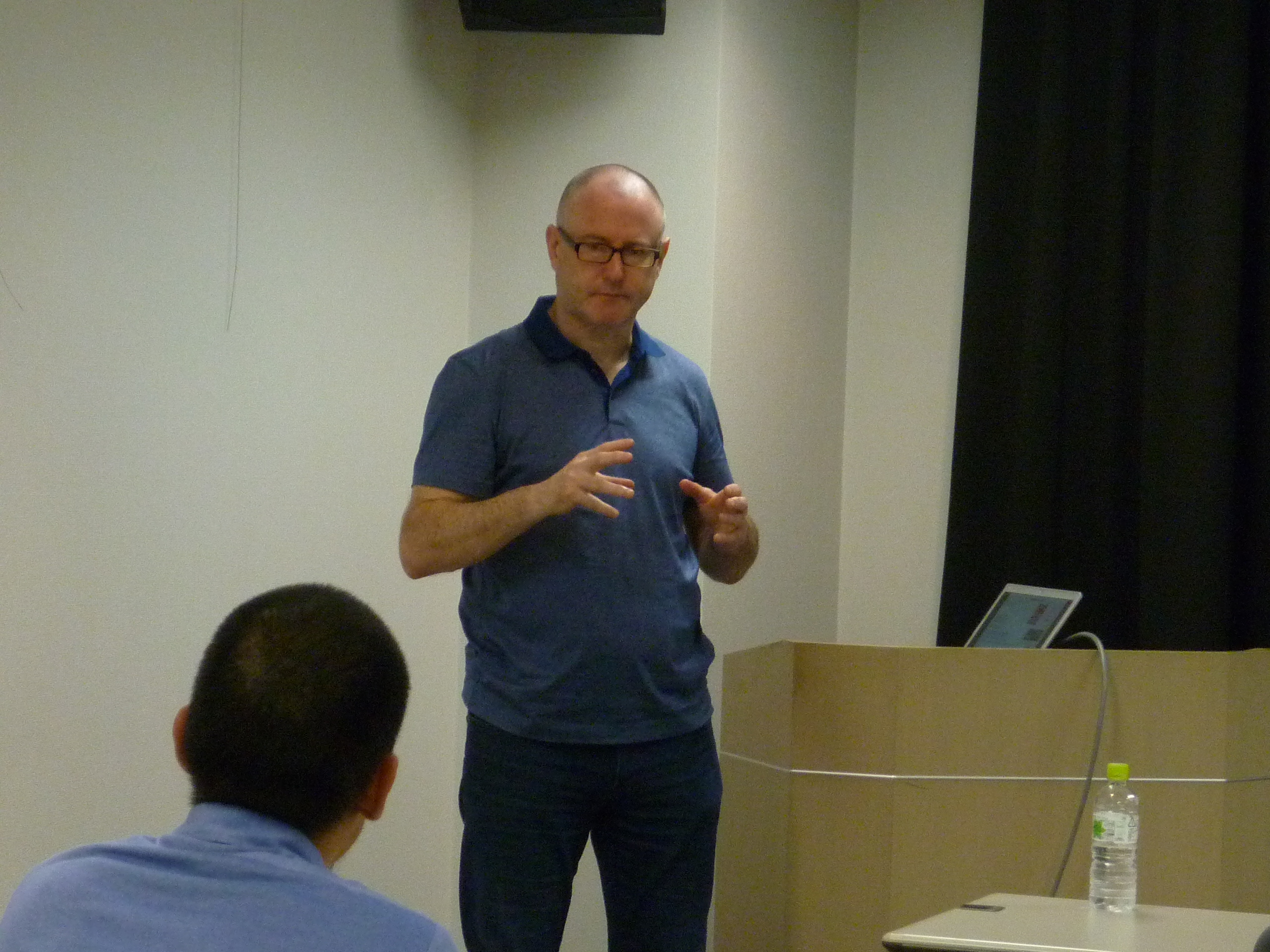 |
Date: 2019/3/27 PM3:00~4:00
Speaker:Hyoung Kyu Kim,Associate professor (Cardiovascular and Metabolic Disease Center (CMDC). Inje University)
Title: A novel role of tetrahydrobiopterin in cardiovascular system
Diabetic cardiomyopathy (DCM) is a major cause of mortality and morbidity
in diabetes mellitus patients. Although tetrahydrobiopterin (BH4) shows
therapeutic potential as an endogenous target in the cardiovascular system,
its effect on myocardial cells and mitochondria in DCM and the underlying
mechanism are unknown. We tested whether BH4 deficiency is involved in
DCM and if supplementation restores mitochondrial and heart function in
late-stage DCM. The transcription of three BH4 synthesis-regulating genes
was compared in cardiac tissues of patients with low or normal ejection
fractions (EFs). Forty-eight-week-old type 2 diabetic rats were divided
into BH4 treatment and control groups. BH4 levels and the functions of
heart and mitochondria were assessed in diabetic or control rats. Sepiapterin
reductase knockout (Spr-/-) mice, a model of BH4 deficiency, were used
to determine the mechanism of the therapeutic effect of BH4 on DCM. Relative
to control rats, diabetic rats, as well as Spr-/- mice, had cardiac contractility,
hypertrophic remodeling, and mitochondrial dysfunction, which recovered
with BH4 supplementation. BH4 directly bound to CaMKK2 and activated downstream
pathways in cardiomyocytes. BH4 is a novel therapeutic target for recovering
the left ventricular contractility and structural remodeling in DCM via
direct binding and activation of CaMKK2 signaling pathways. |
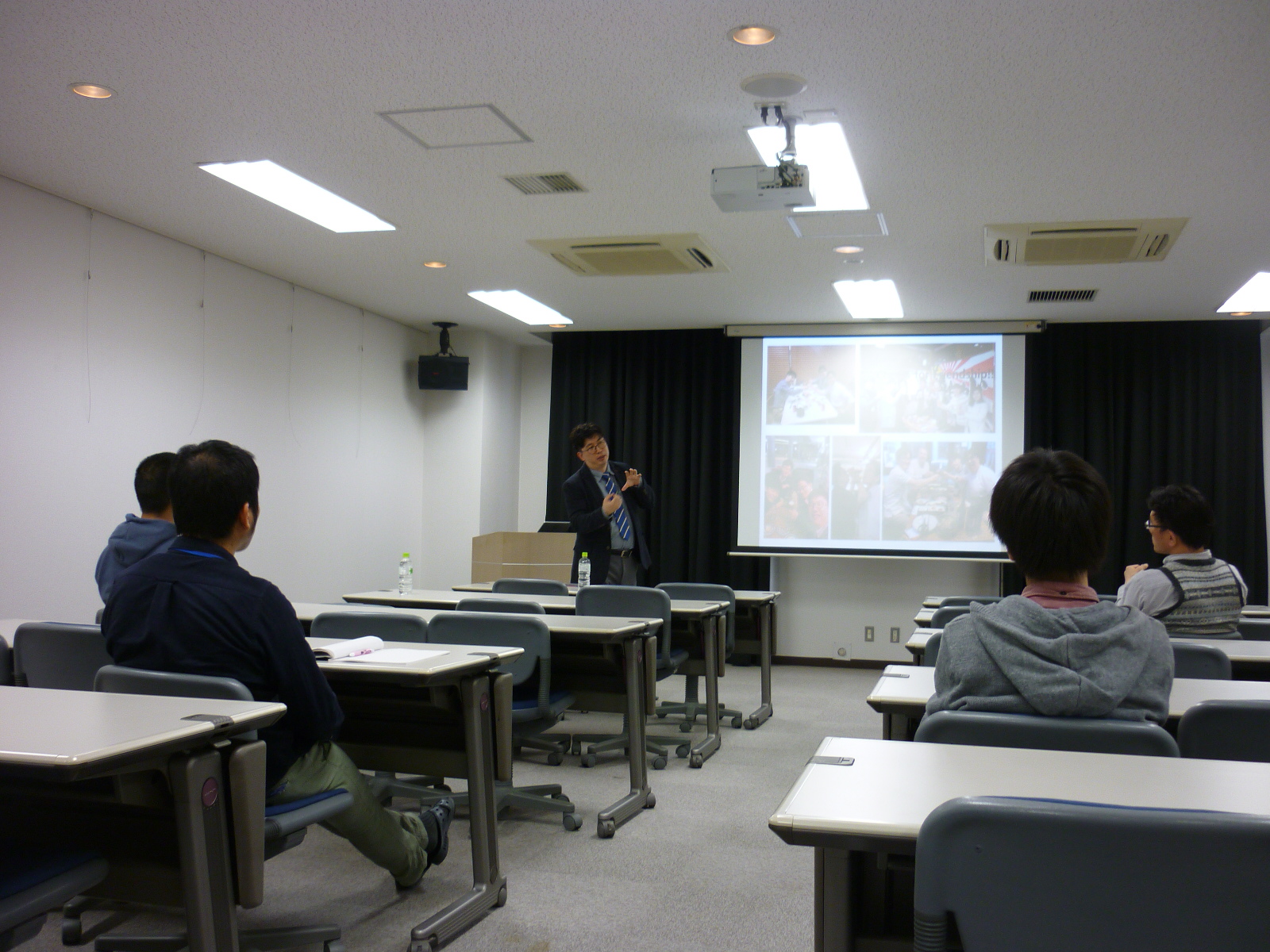 |
Date: 2019/3/27 PM4:00~5:00
Speaker: Jin Han,Professor (Department of Physiology, College of Medicine, Inje University)
Title: Physiological role of AMPK alpha activity inhibitory protein in
heart and mitochondria
Background and Purpose: Cereblon (CRBN) is an interacting protein with large-conductance calcium-activated potassium channels. A mutation of CRBN causes a mild type of mental retardation in humans. While, recent study suggested its novel function as AMPK inhibitor via direct interaction with AMPK a1 subunit. Disruption of CRBN gene enhanced hepatic AMPK activity and prevents high-fat diet induced obesity and insulin resistance in mice. The aim of study is to figure out the effect of CRBN KO in heart and its mitochondrial function. Method and Results: Eight weeks of Control (CRBN+/+) and CRBN KO (CRBN-/-) models were examined their body weight, heart rate and heart/body ratio. In vivo cardiac functions of animals were assessed by echocardiography. To evaluate mitochondrial function of those animals, cardiac mitochondria of CRBN+/+ and CRBN-/- were isolated then examined their ATP contents and ATP production rate, ROS production rate, oxygen consumption rate (OCR) and membrane potential (ΔΨm). As results, the body weight, heart weight and heart/body ration were not significantly different between CRBN+/+ and CRBN-/- mice. Echocardiography showed enhanced cardiac contractility in CRBN-/- mice based on increased ejection fraction (%) and fractional shortening (%). In their mitochondria, basal ATP contents and substrate/ADP stimulated ATP production rate were significantly higher in CRBN-/- mice than CRBN+/+. In addition, basal H2O2 level and rotenone induced ROS production rates were significantly lower in CRBN-/- mice than CRBN+/+. CRBN KO mice showed higher single cell contractility with higher Ca2+ transient amplitude in isolated left ventricular cardiac myocytes.
Conclusion: Our results suggested that CRBN is an important mitochondrial
functional regulator which link cytosol to mitochondrial energy metabolic
signaling.
Keyword: Cereblon, cardiac contractility, mitochondrial energy metabolism.
|
|
Date: 2019/1/4 PM3:30~4:30
Speaker:富田 泰輔 教授 (東京大学大学院薬学系研究科機能病態学教室 Laboratory of Neuropathology and Neuroscience, Graduate School of Pharmaceutical
Science, The University of Tokyo)
Title: Understanding the molecular/cellular pathology and emerging strategies
for Alzheimer disease
Abstract Body: Aggregated forms of amyloid-β peptide (Aβ) and tau are
major components of senile plaques and neurofibrillary tangles, respectively,
which are pathological hallmarks in the brains of Alzheimer disease (AD)
patients. Several lines of evidence suggest that accumulation of Aβ induces
the tau-mediated neuronal toxicity and symptomatic manifestations of AD.
Thus, facilitation of the clearance of aggregated Aβ and tau has been highlighted
as a plausible therapeutic for AD. In addition, genetic studies in AD implicate
the pathological roles of glial cells, such as astrocytes and microglia.
We recently identified kallikrein-related peptidase 7 (KLK7) as a novel
aggregated Aβ-degrading enzyme secreted from astrocyte, suggesting that
astrocyte is a cellular target in AD therapeutics. Moreover, we have developed
a novel small compound called photooxygenation catalyst that facilitates
the selective degradation of aggregated proteins in vivo. I will discuss
with these novel approaches for anti-aggregated proteins against AD.
|
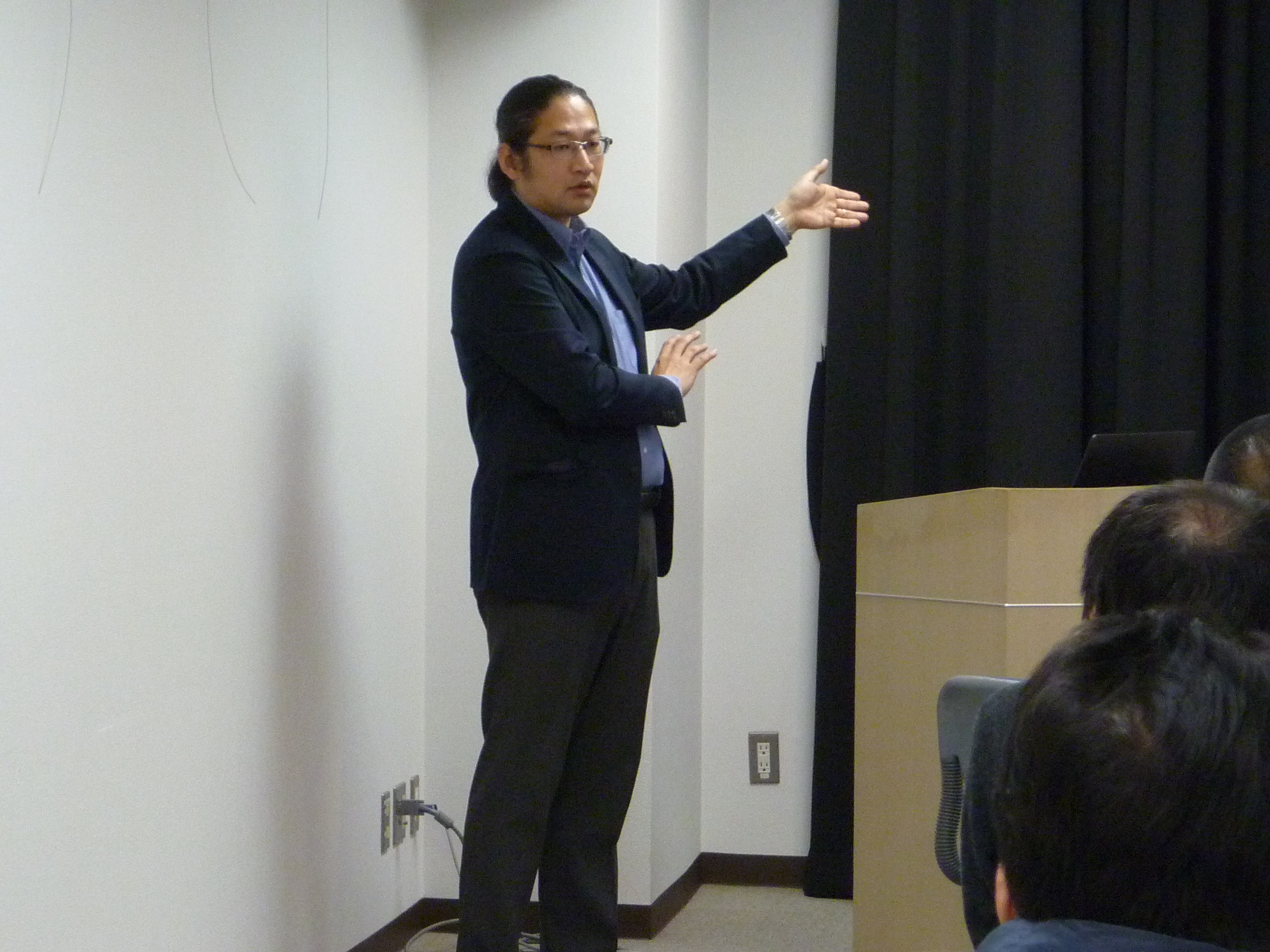 |
Date: 2019/1/4 PM5:00~6:00
Speaker:竹内 英之 准教授 (名古屋大学大学院医学系研究科・機能分子制御学)
Title: O-結合型糖鎖修飾のNotch シグナルにおける重要性~糖鎖による受容体の活性化制御とその異常による先天性疾患
Title: Significance of O-linked glycosylation in Notch signaling~Regulation
of Notch signaling by O-linked glycosylation and human congenital disorders
Notch シグナルは多細胞生物の発生過程や成体の幹細胞など、細胞の運命決定に非常に重要な役割を果たす。
近年の遺伝学および生化学的な研究によって、Notch 受容体自体の O-結合型糖鎖修飾 (O-フコース、O-グルコース、O-GlcNAc) が、巧妙にシグナルの調節に関わっていること、
さらに、これらのO-結合型糖鎖修飾を担う糖転移酵素遺伝子の変異が、Dowling-Degos 病、肢帯型筋ジストロフィー、Adams-Oliver
症候群など様々なヒトの先天性疾患の原因となることが明らかとなってきた。
本講演では、O-結合型糖鎖修飾が Notch 受容体の活性化を制御する分子メカニズムに関する、生化学、構造生物学、そして、ケミカルバイオロジーツールを用いた最新の研究成果を紹介させて頂く。
Notch signaling plays significant roles for cell-fate decisions during
development and adulthood. Recent genetic and biochemical studies revealed
that O-linked glycosylation (O-fucose, O-glucose, and O-GlcNAc) on Notch
exquisitely regulates its activation and that a number of mutations in
the glycosyltransferase genes cause human congenital disorders such as
Dowling-Degos disease, Limb-girdle muscular dystrophy, and Adams-Oliver
syndrome. I would like to introduce cutting-edge research on the molecular
mechanisms by which O-linked glycosylation regulates Notch signaling through
multidisciplinary efforts from biochemistry, structural biology, and chemical
biology.
|
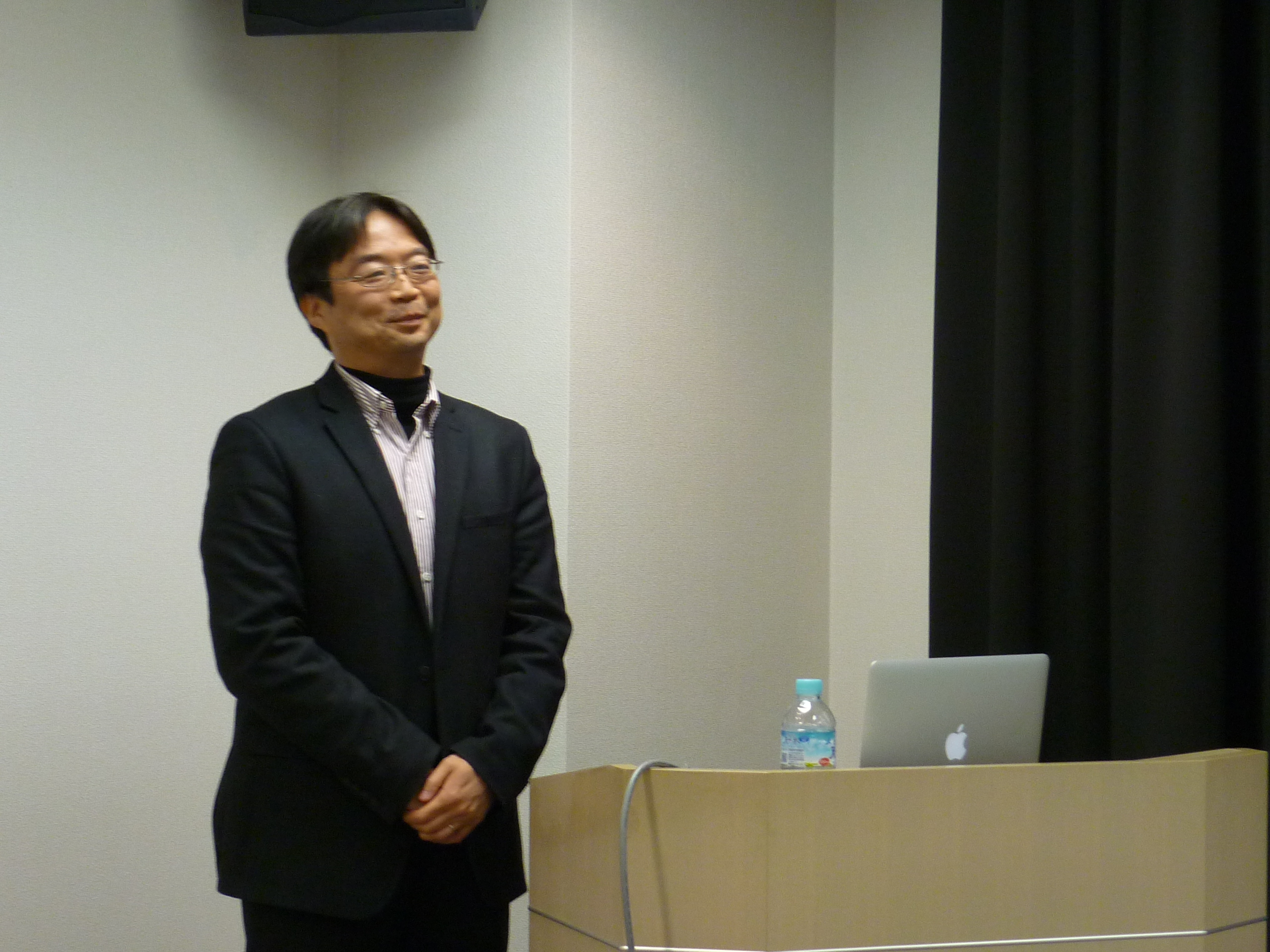 |
|
| |
| |
2018
|
Date: 2018/1/30 PM4:00~5:00
Speaker:Amira Hajirah Abd Jamil (PhD)(Department of Pharmacy, Faculty of Medicine, University of Malaya,KualaLumpur
Malaysia・Senior lecturer)
Title:Cardiac substrate metabolism following hypoxia: Role of Peroxisome
Proliferated receptor alpha (PPAR)
The principal substrate used by the normal adult human heart is free fatty acids, the remainder being, predominantly, carbohydrate. During failure, the heart becomes less reliant on fatty acid metabolism, possibly as a result of tissue hypoxia. Therefore, understanding hypoxic adaptation may explain the metabolic changes that occur during the development of heart failure and potential therapeutic advancement. As peroxisome proliferator activated receptor alpha (PPARα) modulates cardiac fatty acid metabolism, we investigated the role of PPARα in cardiac metabolic adaptation to chronic hypoxia. We have reported isolated hearts from chronically hypoxic (11% O2 for 3 weeks) mice were more glycolytic, had reduced PPARα expression and decreased fatty acid metabolism, but had normal function, determined using in vivo cine-MRI. 31P MRS of isolated perfused mouse hearts showed a drop in phosphocreatine (PCr) with hypoxia, but ΔGATP was not altered, indicating that metabolic reprogramming was sufficient to maintain ATP production and contractile function. Increased or decreased PPARα expression, using a high fat diet or PPARα null mice, respectively, prevented metabolic adaptation to hypoxia and caused cardiac dysfunction. Cardiac vascular endothelial growth factor (VEGF), prominent hypoxia-inducible factor (HIF) target, was increased by hypoxia, indicating that HIF may have been involved in metabolic adaption. In order to determine the relationship between HIF and PPARα, HIF was stabilised pharmacologically using FG2216/BIC in HL-1 cardiomyocytes, to show decreased PPARα expression and caused similar metabolic changes to those seen in the in vivo hypoxic heart. We proposed that HIF-mediated downregulation of PPARα is crucial for metabolic adaptation and maintenance of cardiac function during chronic hypoxia.
|
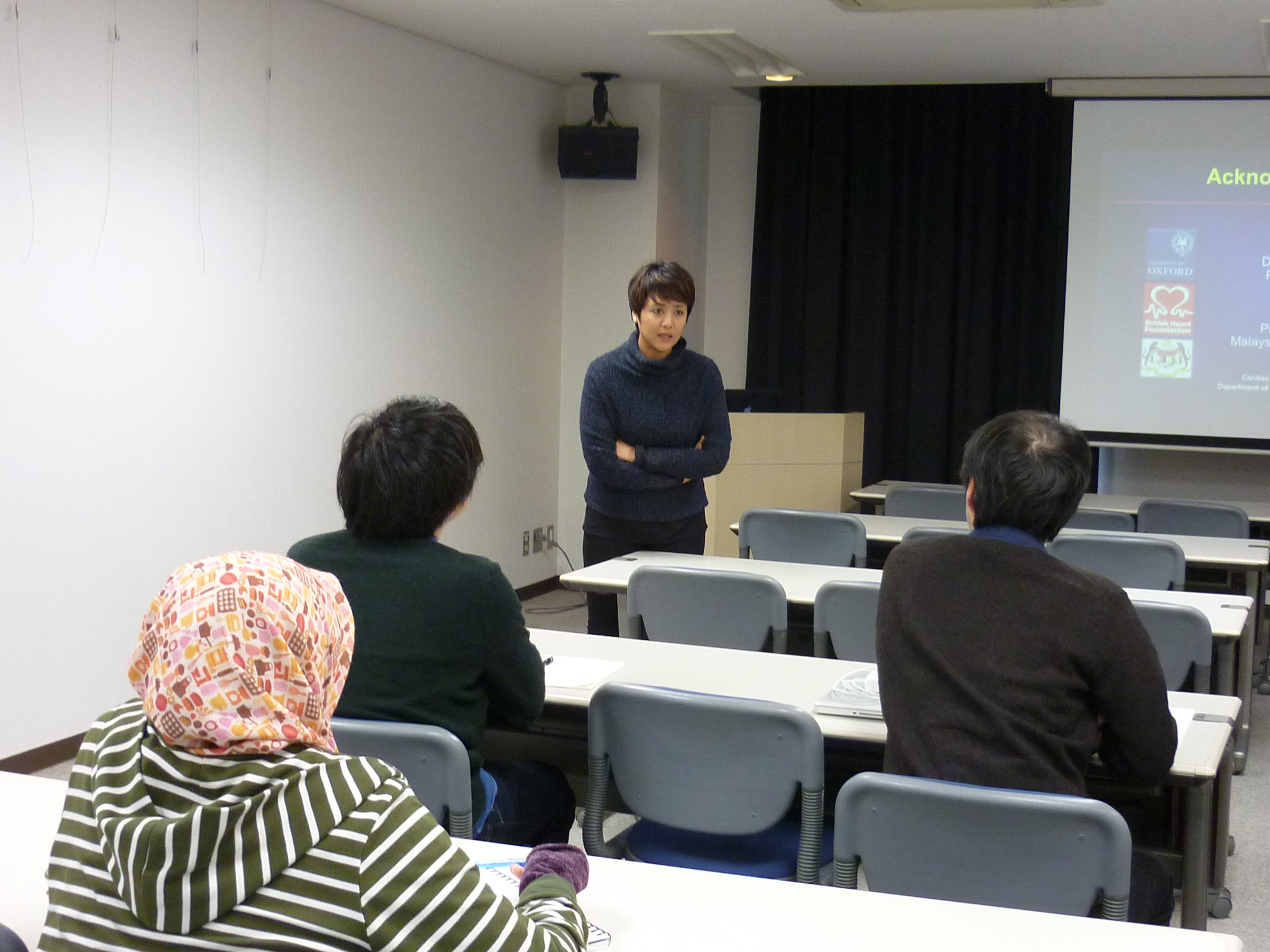 |
Date: 2018/1/15 PM4:00~5:30
Speaker:Prof.Jin Han(National Research Laboratory for Mitochondrial Signaling, Department of
Physiology, College of Medicine, Cardiovascular and Metabolic Disease Center,
Inje University)
Title:Pharmacological rescue of mitochondria during heart disease
Tetrahydrobiopterin (BH4) has been suggested to regulate cardiac mitochondrial
function as a multifunctional cofactor and an antioxidant, an important
role in the cardiovascular system. However, its mechanism on transcriptional
coactivators such as peroxisome proliferator activated receptor γ coactivator-1
(PGC1) α and AMP-activated protein kinase (AMPK) signaling, major regulators
of energy metabolism in heart, is unknown. Aim of this study was to assess
the role of BH4 in the PGC1-α and AMPK signaling in the hearts of mammalian
animal. Using a sepiapterin reductase (Spr) knockout mouse, a model of
BH4 deficiency, we found that BH4 regulates transcription of PGC1-α and
phosphorylation of AMPK α and β and the expression of their target proteins
involved in mitochondria biogenesis (mtTFA, and ERRα), antioxidant (Prx3
and SOD2) and fatty acid utilization (CD36 and CPTI-M) in the hearts. BH4
can binds to Calcium/Calmodulin-Dependent Protein Kinase Kinase 2 (CaMKK2)
then activates CaMKIV mediated CREB phosphorylation and AMPK phosphorylation
in the heart of model mice. Spr KO mice have shown the development of a
lethal cardiomyopathy with mitochondrial dysfunction and exogenous BH4
supplementation successfully rescued those phenotypes. These results reveal
a novel molecular mechanism of BH4 in the regulation of cardiac energy
metabolism and suggest that BH4 has therapeutic potential for the cardiomyopathy.
|
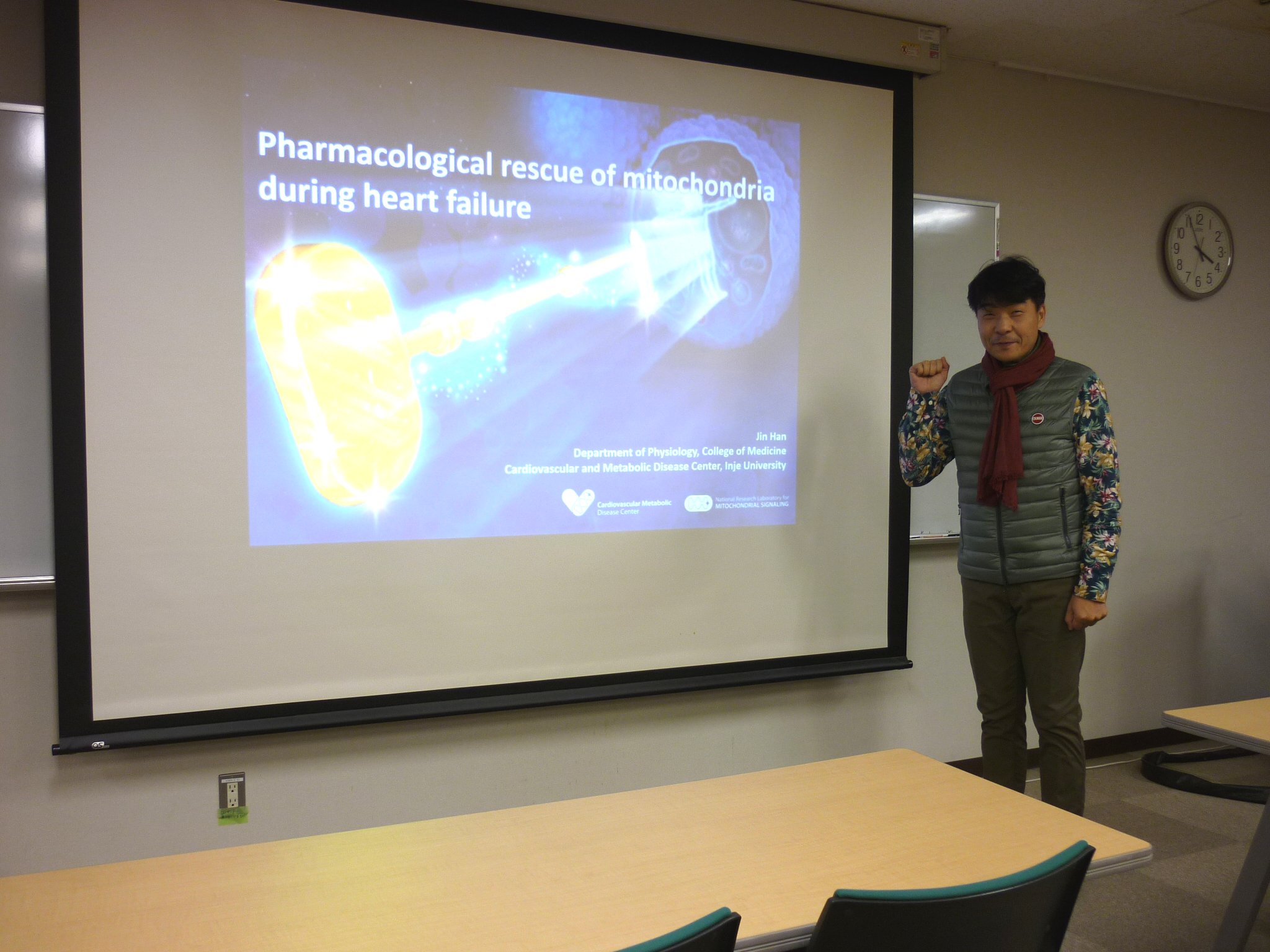 |
|
|
| |
2017
|
Date: 2017/10/13 PM3:00~4:30
Speaker:本田 直樹 先生 (京都大学大学院生命科学研究科 特定准教授)
Title:予測的アプローチによる生体情報処理の同定
分子生物学の発展により細胞内シグナル伝達を担う分子経路が詳しく同定されてきている。しかし、細胞が実際にどのような情報処理(入出力変換)を行っているのかについては良く分かっていない。一方で、ライブイメージングなどの計測技術が発展し、生体情報処理を反映しているであろう動態を定量化することが可能になっている。そこで我々は、定量データから機械学習を用いて細胞の挙動を予測することで、生体情報処理の様式を抽出する予測的アプローチを行ってきた。今回の発表では、データ解析の考え方を概説し、いくつかの研究成果を紹介する。
|
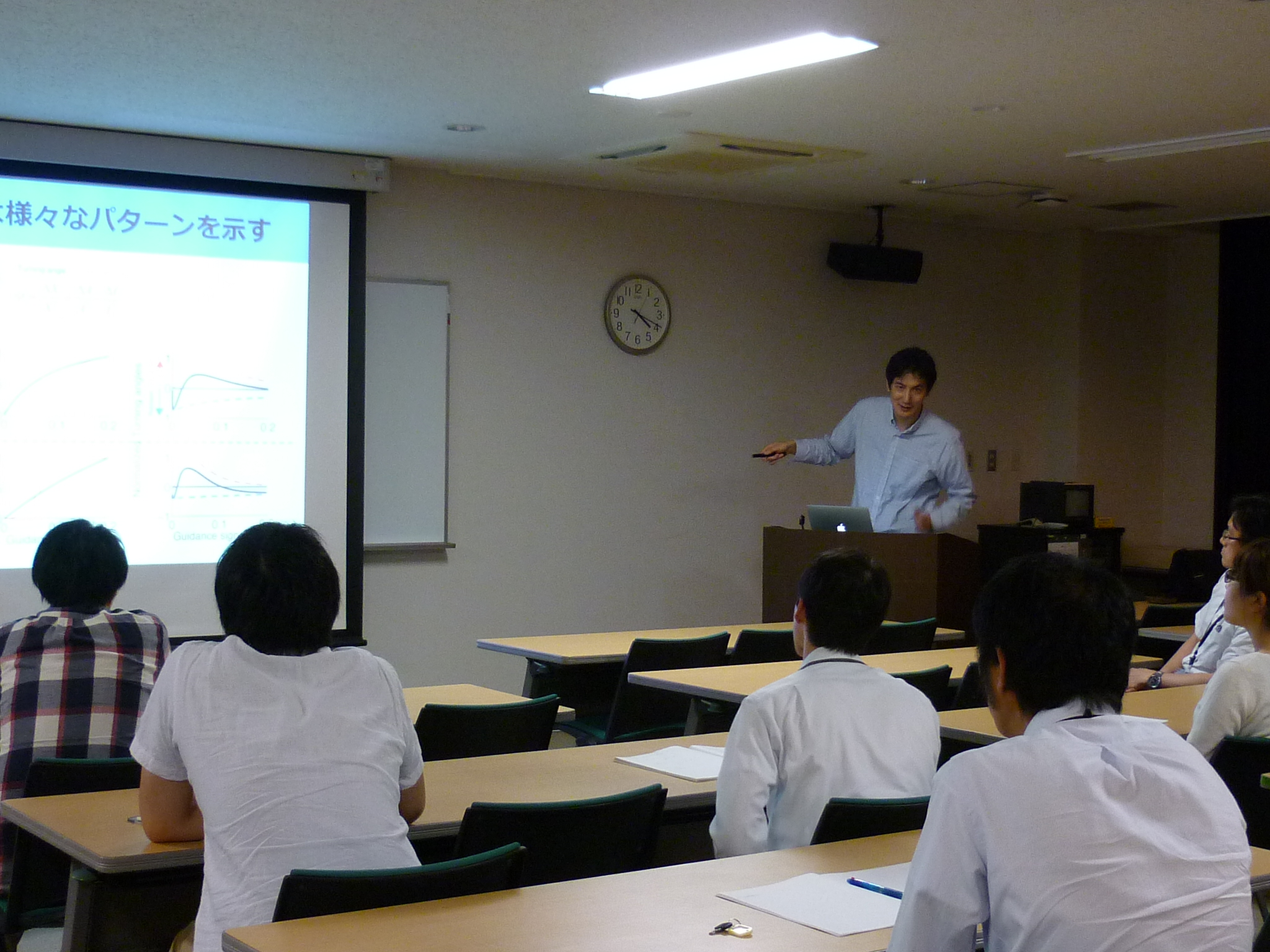 |
Date: 2017/7/14 PM3:00~4:00
Speaker:田中 智弘 (NIPS リサーチフェロー)
Title:細胞外マトリクス分子リモデリングによる運動ニューロン変性の抑制機構
筋萎縮性側索硬化症(ALS)の進行に伴い、脊髄に存在する運動ニューロン は変性し、標的骨格筋の麻痺を引き起こす。その変性過程において、運動ニューロン
は細胞死に先立ち、軸索末端が標的骨格筋から退縮する「除神経(denervation)」 と呼ばれる現象がALS患者、モデルマウスにおいて認められ、運動機能低下の直接的
な原因と考えられている。しかし除神経をターゲットとしたALS治療アプローチには 未解明の点が多く残されていた。今回私たちは、神経―筋インターフェースに存在す
る細胞外マトリクス分子が除神経を抑制する可能性を検討し、1)細胞外マトリクス 分子のリモデリングを引き起こす緩徐な運動によってALSモデルマウスの除神経が抑
制されること、2)運動により細胞外マトリクス分子であるラミニンβ2がシナプス 領域特異的に集積し、アクティブゾーンなどシナプス前終末の構造体を安定化するこ
とで除神経を遅延させる役割があることを明らかにした。今後、このような細胞外マ トリクス分子を中心とした除神経を抑制・遅延させるメカニズムを解析していくこと
で、ALSなど除神経による運動機能低下を抑えるような新たな治療ターゲットの解明 が期待される。
|
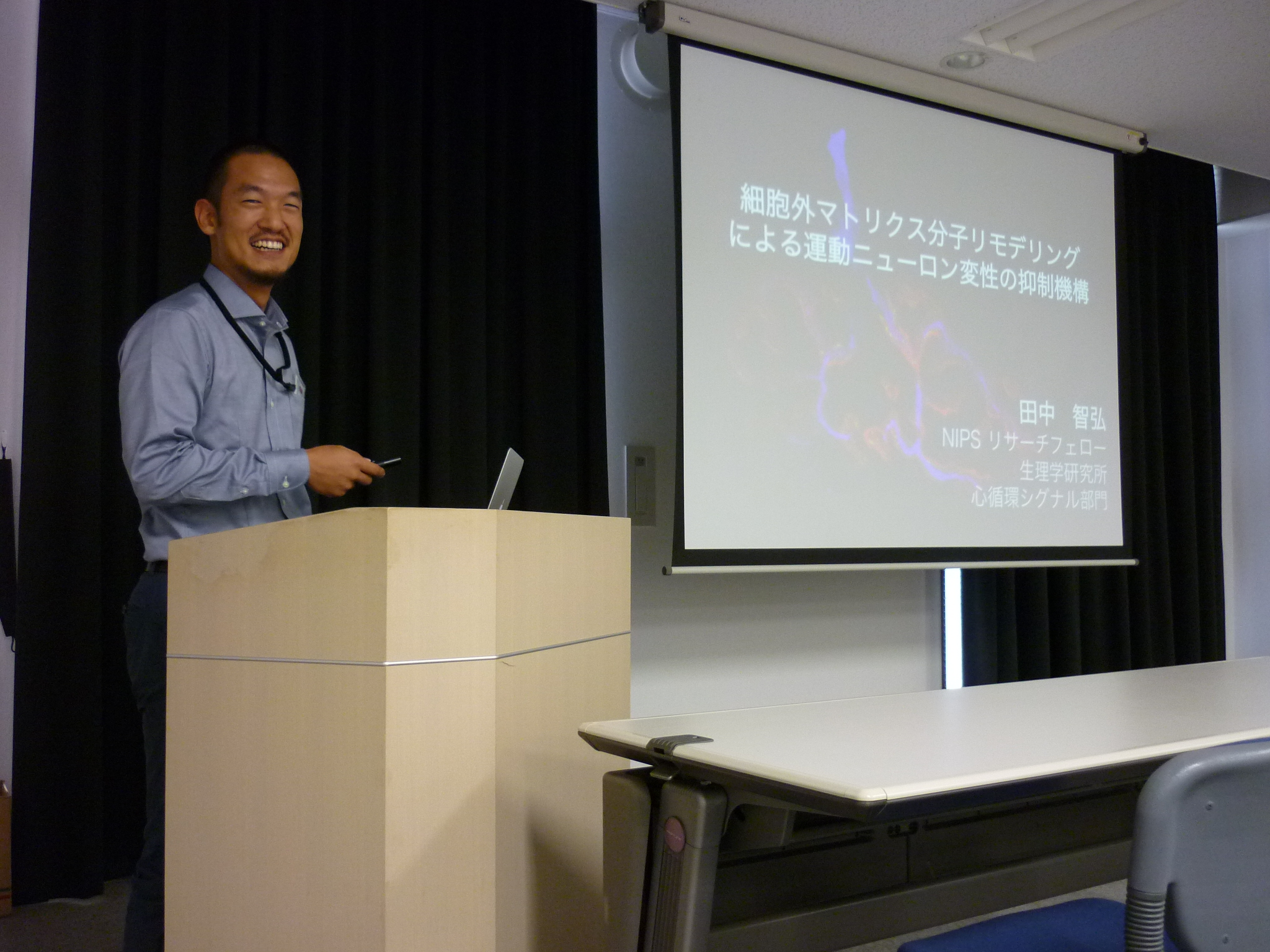 |
Date: 2017/1/27 PM4:00~5:00
Speaker:Prof. Yoshifumi Yamaguchi (The University of Tokyo)
Title: Toward understanding mechanisms of mammalian hibernation ~ an approach
with Syrian golden hamsters
Hibernation is an adaptive strategy to survive cold winter with little
or no food. Some of mammals can hibernate to survive during the winter
months by suppressing metabolisms and lowering body temperature and heart
rate. Since these physiological changes are lethal to most mammals including
mouse and human, it is of great interest from both basic sciences and clinical
application to understand mechanisms that enable hibernation. Two fascinating
topics in the mysteries of hibernation are “seasonal (chronic) body remodeling
for hibernation” and “regulation of deep torpor (immobility state with
low body temperature) and periodic arousal during hibernation”. We have
tackled the topics by examining one of ideal animal models for hibernation
research, Syrian golden hamsters (Mesocricetus auratus); they can enter
hibernation throughout the year irrespective of seasons when exposed to
a short day photoperiod and cold ambient temperatures under laboratory
conditions. In this seminar, I will introduce our recent findings and discuss
how hamsters achieve proper hibernation.
|
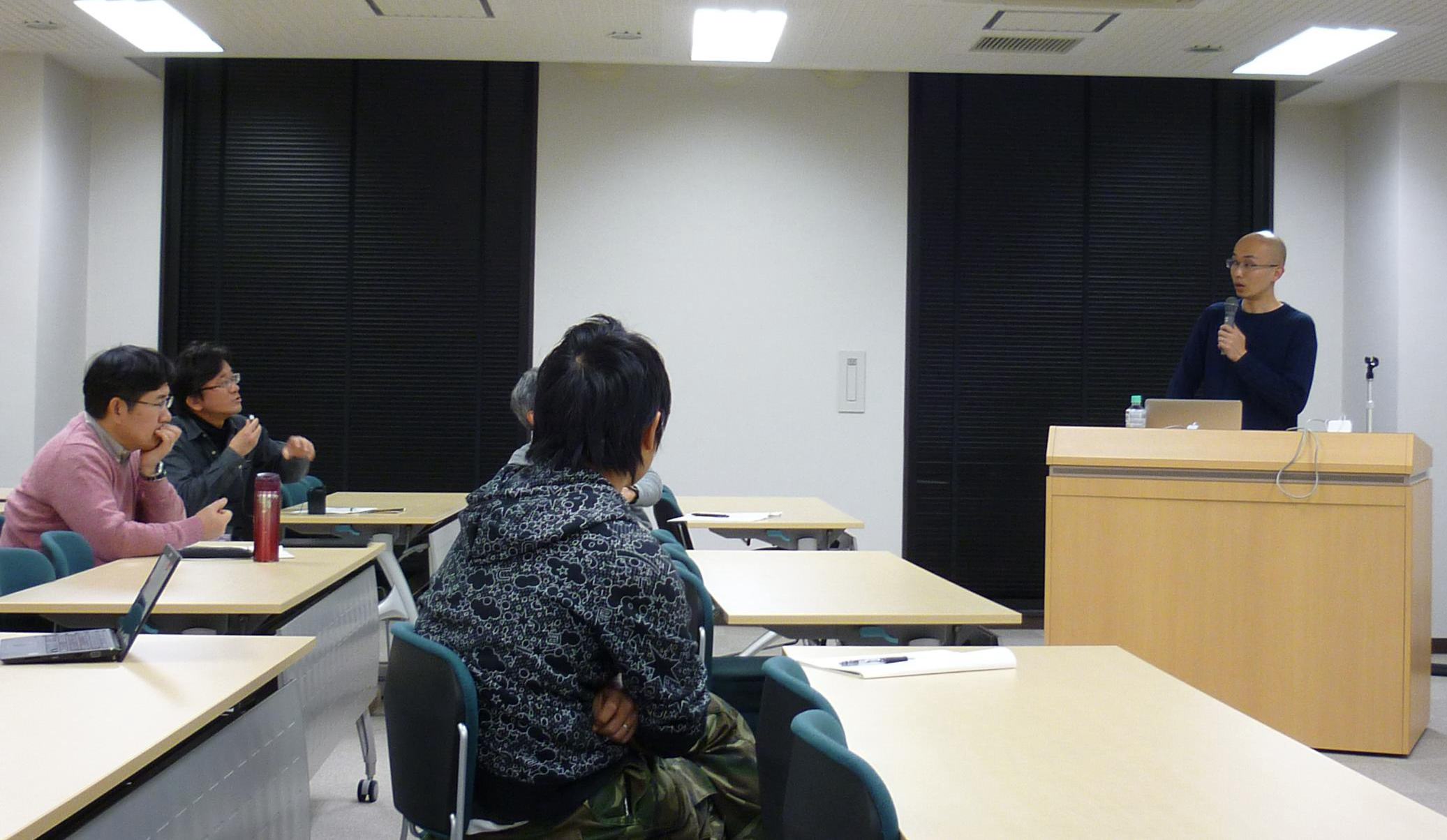 |
|
| |
2016
|
Date: 2016/11/25 PM5:00~6:00
Speaker:成瀬 恵治 教授(Prof. Keiji Naruse) 岡山大学大学院医歯薬学総合研究科(医)システム生理学
Title: メカノメディスン:メカノトランスダクション研究とその臨床応用
我々の体は外界からだけではなく体内においても様々な力学的・機械的刺激(メカニカルストレス)を受容し、応答することで正常な生理 機能を維持している.メカニカルストレスの受容応答機構は細胞分裂、発生過程、臓器機能発現など広範な時空間スケールにわたる生理機 能の調節に寄与しており、メカニカルストレス受容応答機構の破綻が様々な病態に関与していることを示唆するエビデンスが集積されてき た.メカノセンサー分子→細胞→組織→臓器→個体レベルでの縦糸的研究に各種臓器の疾患という横糸的研究を加えた布陣をとり、メカノ バイオロジーを切口とした病態解明を基に、新規治療法を開発するメカノ医療(メカノメディスン)の確立を目指し、これまでに数々の新 規研究方法や研究システムを開発し問題を解決してきた. 本講演ではメカノバイオロジーに関する基礎医学的研究、特にメカニカルストレス受容機構を概説し、その研究過程で派生した再生医療( 自己集合化ペプチドを用いた3次元培養+メカニカルストレス負荷システム)・生殖補助医療(マイクロ流路良好運動精子分離システム・ス トレッチ刺激負荷受精卵培養システム)への展開を紹介する。
|
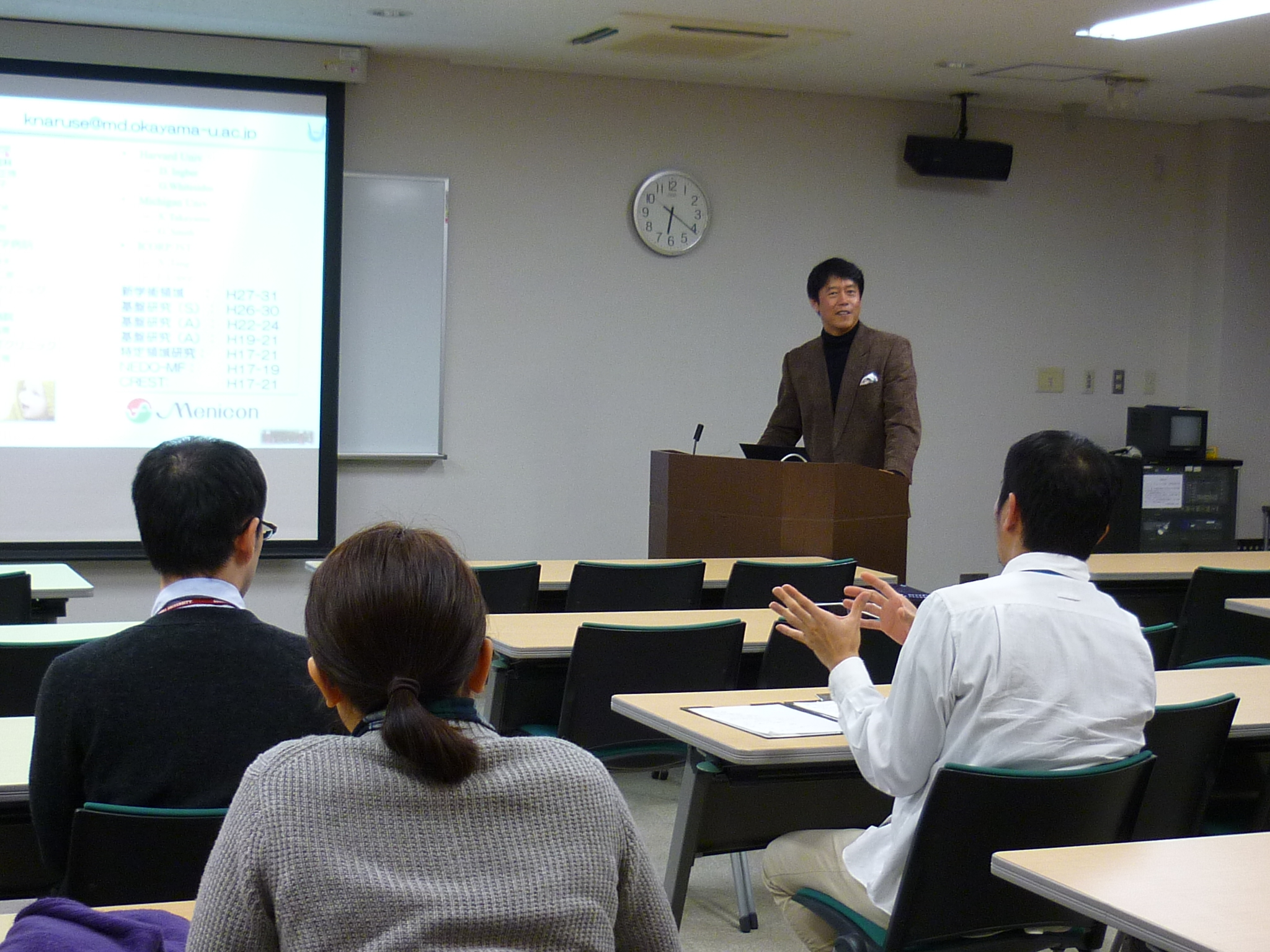 |
Date: 2016/11/25 PM4:00~5:00
Speaker:高井 章 教授(Prof. Akira Takai)
所属:旭川医科大学 生理学講座 自律機能分野
Title:毛様体平滑筋の収縮調節に関与する非選択性陽イオンチャネルの分子実体
視覚遠近調節を司る毛様体筋は典型的な副交感神経支配の平滑筋組織の一つである。この筋には、膜表面のM3型ムスカリン受容体刺激に応 じて開口する、単位コンダクタンスが100
fS と35 pSと大きく異なる2種類の非選択性陽イオンチャネル(NSCCSとNSCCL)が存在する。そのう ち、いわゆるstore-operated
Ca2+ channel (SOC)様の性質を示すNSCCSについては、安定的な視覚焦点合わせに重要な筋収縮持続相の維持 に必要な細胞外からのCa2+の流入経路として機能することが予想されてきた。しかし、実験に供しうる十分な数の健常な単離毛様体筋細胞 を得ることが難しいことが制約となり、NSCCSの分子実体の解明はなかなか進まなかった。最近われわれはコラゲナーゼ処理とPercoll密度
勾配遠心分離によりウシ毛様体筋組織から平滑筋細胞を高純度に取り出す方法を開発した。それにより調整した単離筋細胞を用いてsiRNA法 などによる実験をおこなったところ、SOCの本体として注目されているSTIM1/Orai1とNSCCSとの関連を強く示す知見が得られた。
In bovine ciliary muscle (BCM), stimulation of M3-muscarinic receptors
opens a non-selective cation channel (NSCC) with a ve ry low unitary conductance
(100 fS), which serves as the major pathway for Ca2+ entry during sustained contraction. The mole cular entity of this channel
has been unknown, mainly because of the technical difficulty of obtaining
BCM cells with suffic ient purity. Recently we developed a new method which
has enabled to obtain BCM cells with unprecedented quality and amount and
applied it to examine the existence and localization of TRPCs, STIM1 and
Orai1. The ciliary body dissected from bovine e ye was treated with collagenase,
and the dispersed cells were subjected centrifugation through a discontinuous
Percoll densi ty-gradient of 1.050 and 1.060 g/mL. Cells were then collected
from the 1.050/1.060 interface and cultured for 1-3 days befo re use. In
the cultured BCM cells, carbachol (2 μM) evoked a phasic and tonic increase
of [Ca2+]i monitored with fluo-4 flu orophore. These responses were clearly observed
in 5 × 106 cells obtained by the single-step centrifugation procedure.
Part ial knockdown of STIM1 by siRNA resulted in a 60% reduction of the
tonic component of the carbachol-induced rise of [Ca2+]i.
|
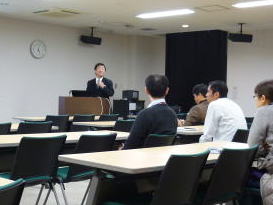 |
Date: 2016/4/22 PM5:00~6:00
Speaker:金保 安則 教授(Prof. Yasunori Kanaho) (筑波大学医学医療系(生命医科学域)生理化学研究室 (Dept. of Physiological Chemistry, Faculty of Medicine, Univ. of Tsukuba)
)
Title: 低分子量G蛋白質Arf6の意外な病理学的および生理学的機能
(Unexpected pathological and physiological significance of the small G
protein Arf6)
低分子量G蛋白質のArf6は、シグナル伝達系において分子スイッチとして機能しており、細胞レベルで細胞膜ダイナミクスに関連した細胞機 能を制御している。我々は、1999年にArf6がリン脂質キナーゼのPIP5Kの活性をして細胞膜形態を制御するという非常に興味深い発見をして 以来、Arf6の個体レベルでの生理学的および病理学的機能への関与について解析を進めており、Arf6シグナル伝達をターゲットとした創薬 開発を模索している。本セミナーでは、これらの点について、極めて新規な知見を紹介し、議論したい。
The small G protein Arf6 functions as a molecular switch in various signal
transduction systems and regulates membrane dynam ics-based cellular events.
In 1999, we found a novel function of Arf6 that this molecule regulates
membrane dynamics through the activation of the lipid kinase PIP5K. Thereafter,
we have been focusing to analyze the physiological and pathological f unctions
of Arf6, and exploring the new drugs targeting Arf6 signaling. In this
seminar I show our recent progress about pat hophysiological functions
of Arf6 and discuss on these data.
|
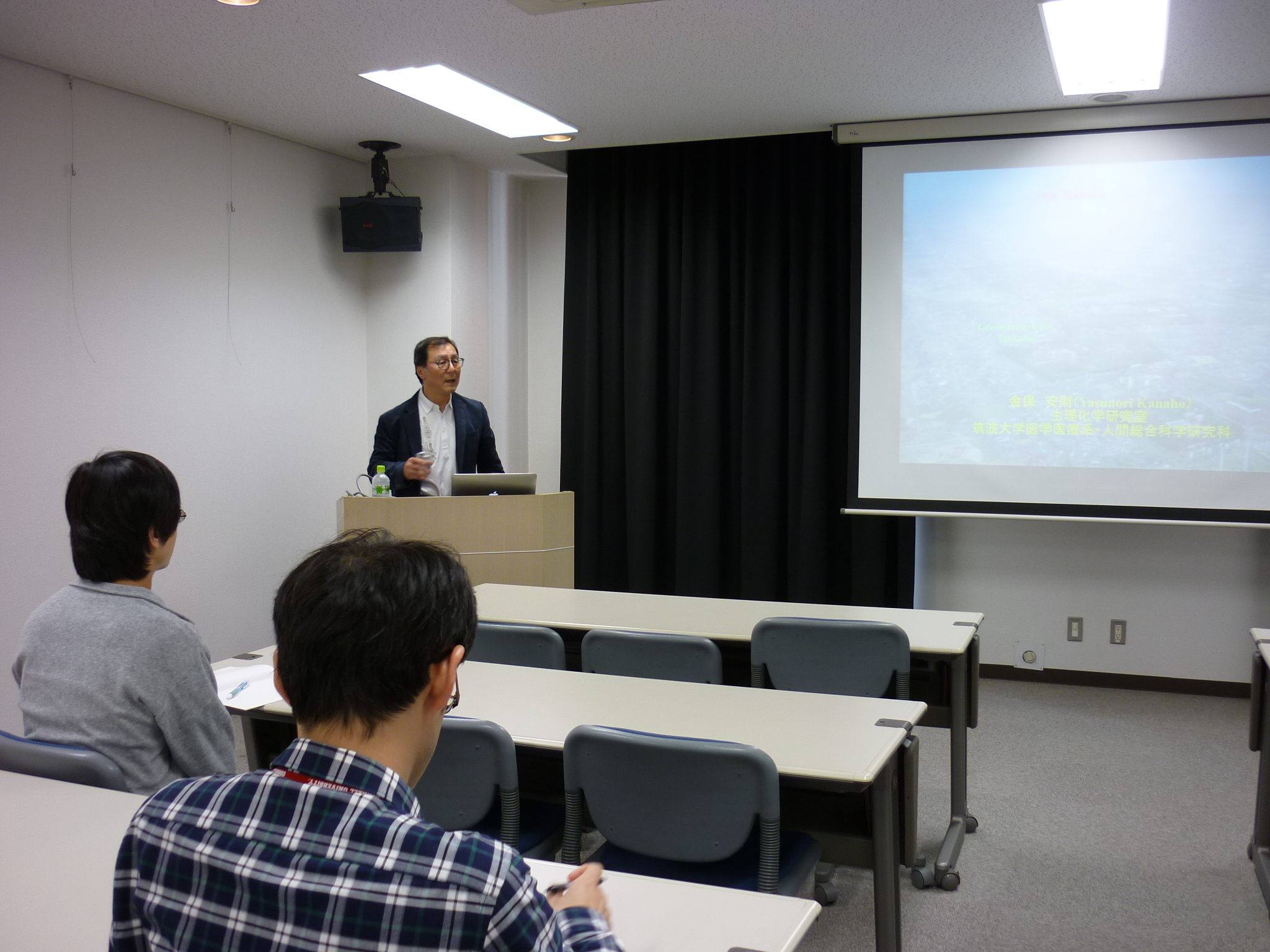 |
|
|
2015
|
Date: 2015/12/12 PM 5:30~PM 6:30
Speaker:Prof. Motonari UESUGI(京都大学 物質-細胞統合システム拠点 副拠点長・教授)
Title: 細胞を操る合成化合物
人間の歴史の中で、生理活性小分子化合物は医薬品、農薬、基礎生物学研究のツールとして利用されてきました。今回の講演では、基礎生 物学ツールの紹介に加えて、生理活性化合物の第4の利用法として、細胞治療を助ける小分子化合物を紹介します。これまでの古典的な医
薬品の枠にとらわれなければ、化合物にはさまざまな可能性や未来が想像できます。新しいサイズ、新しいカタチ、新しい作用メカニズム などを考えれば、化合物の新しい使い方や未来が垣間見えます。
|
|
Date: 2015/12/12 PM 4:00~PM 5:00
Speaker:Prof. Yasuo MORI(京都大学大学院工学研究科 合成・生物化学専攻 生物化学講座 分子生物化学分野・教授)
Title: Relationships of us aerobic living organisms with O2 are more delicate than we think
O2 is essential for aerobic organisms. While this characterization for O2 appears almighty in biology, it is not enough to describe delicate significance
of O2 in vivo. When O2 is highly required to elicit metabolic activity through ATP productio
n in cells and organs, it is very true that their survival is easily endangered
by disruption of O2 supply (hypoxia). Howe ver, recently, evidence has been accumulated that
hypoxia can support certain states of cells and organs. In addition, if
s urplus O2 is provided to cells and organs in the body (hyperoxia), it leads to the production of reactive species responsibl e for oxidative stress that influences and often dysregulates downstream cellular signals. Today, I would like to introduce some of our works on TRP channels that act as sensors for O2 and reactive oxygen species and also as actuators to initiate downstream
electrical/chemical signals, and discuss about how ‘appropriate’ levels
of O2 are attained via TRP channels.
|
|
Date: 2015/8/10 PM 2:00~PM 3:00
Speaker:Prof. Yukihiro AKAO(United Graduate School of Drug Discovery and Medical Information Sciences,
Gihu University)
Title: MicroRNA regulates the cancer-specific Warburg effect through targeting
splicer PTB1
①The Warburg effect has been well known as a feature of cancer specific
metabolism. One of the key molecule of Warburg effect is polypyrimidine
tract-binding protein 1 (PTB1), which is a splicer of the limiting enzymes
pyruvate kinase muscle 1 and 2 (PKM1 and PKM2). Recently, we focus on the
functions of PTB1 and PTB1-associated microRNAs (miRs). In this seminar,
I demonstrate a critical role of miR-1 and -133b on Warburg effect in colorectalcancer
cells. ②We newly found that the mechanisms of TRAIL-resistance consist
of decrease in the expression level of DR5 and malfunction of its recruitment
on the cell surface. Interestingly, α-mangostin which is one of the xanthone
derivatives canceled the resistance by increasing the expression level
of DR5 through down-regulation of miR-133b and effectively induced DR5
to cancer cell surface membrane in TRAIL-resistant DLD-1 cells. I will
discuss concerning the TRAIL-resistance and its attenuation.
|
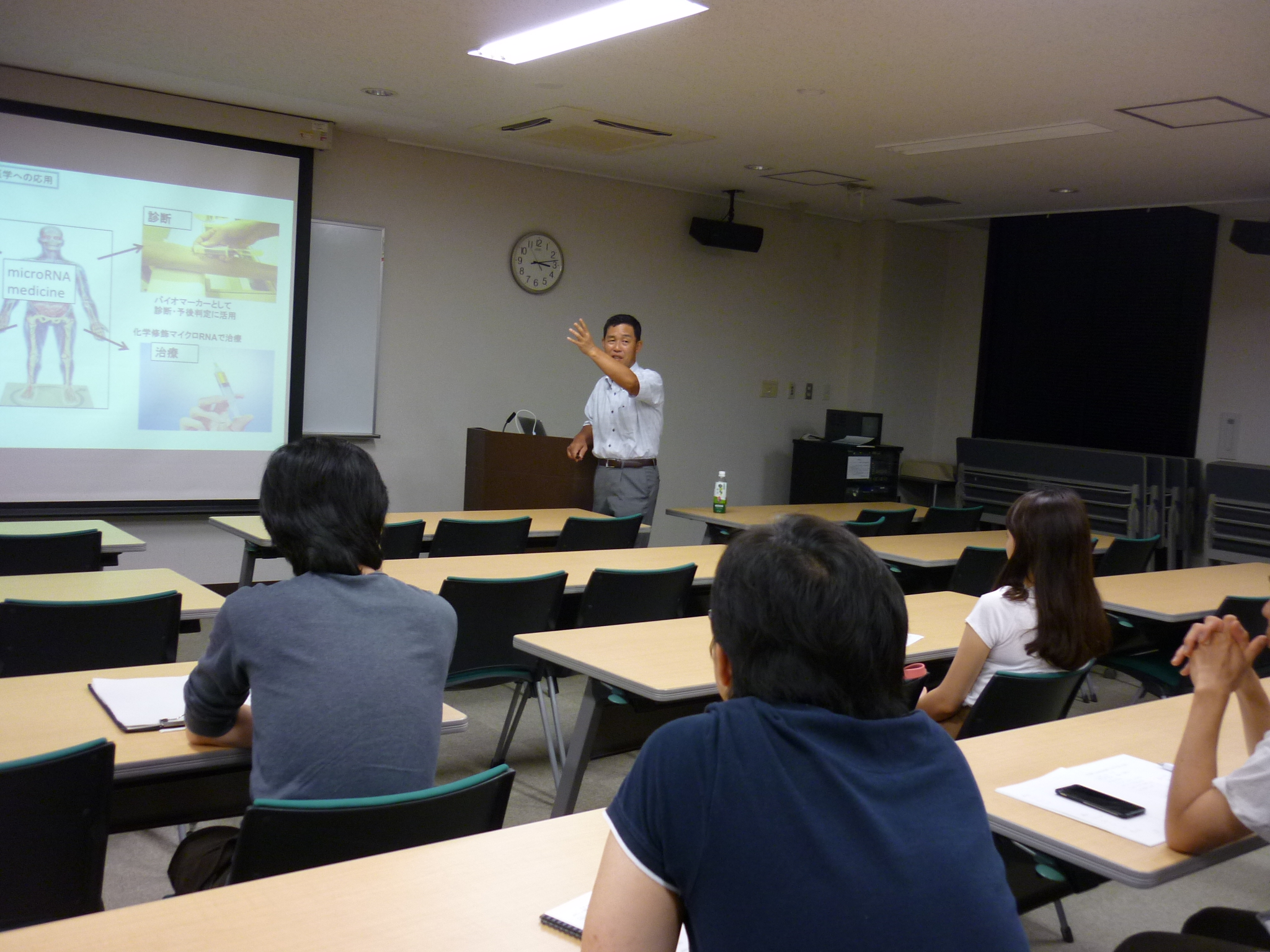 |
Date: 2015/4/21 PM 5:00~PM 6:00
Speaker:Dr. Shigehiro OHDO(Department of Pharmaceutics, Graduate School of Pharmaceutical Sciences, Kyushu University)
Title: Drug discovery on based on molecular clock
Behavioral and physiological rhythms in most living organisms are regulated by the molecular clock system. Alterations in molecular clocks works are associated with various diseases such as cancer, metabolic syndrome, and hypertension. Currently, treatment for such diseases remains unsatisfactory, resulting in unmet medical needs. Hepatocellular carcinoma (HCC) is one such disease with unmet medical needs. Chronic inflammatory and HCC are induced by infection of hepatitis B and C viruses. Interferon (IFN) therapy reduce HCC. However, existing therapy methods are insufficient for correcting chronic hepatitis and HCC. Therefore, we investigated the influence of molecular clock function on the development of chronic inflammatory and HCC. The 24-h expression of clock genes and Ccrf were altered in liver at 14 weeks after treatment of diethylnitrosamine (DEN). The microarray analysis in Ccrf knockdown hepatic cells showed the alteration of pathway in carcinoma and cell cycle. Addition, function of Ccrf protein was regulated the inflammatory signal. The present time, high throughput chemical screening has been performed for discovery of Ccrf inhibitor. Molecular clock function is very important as a new target in the treatment of Chronic inflammatory and HCC.
|
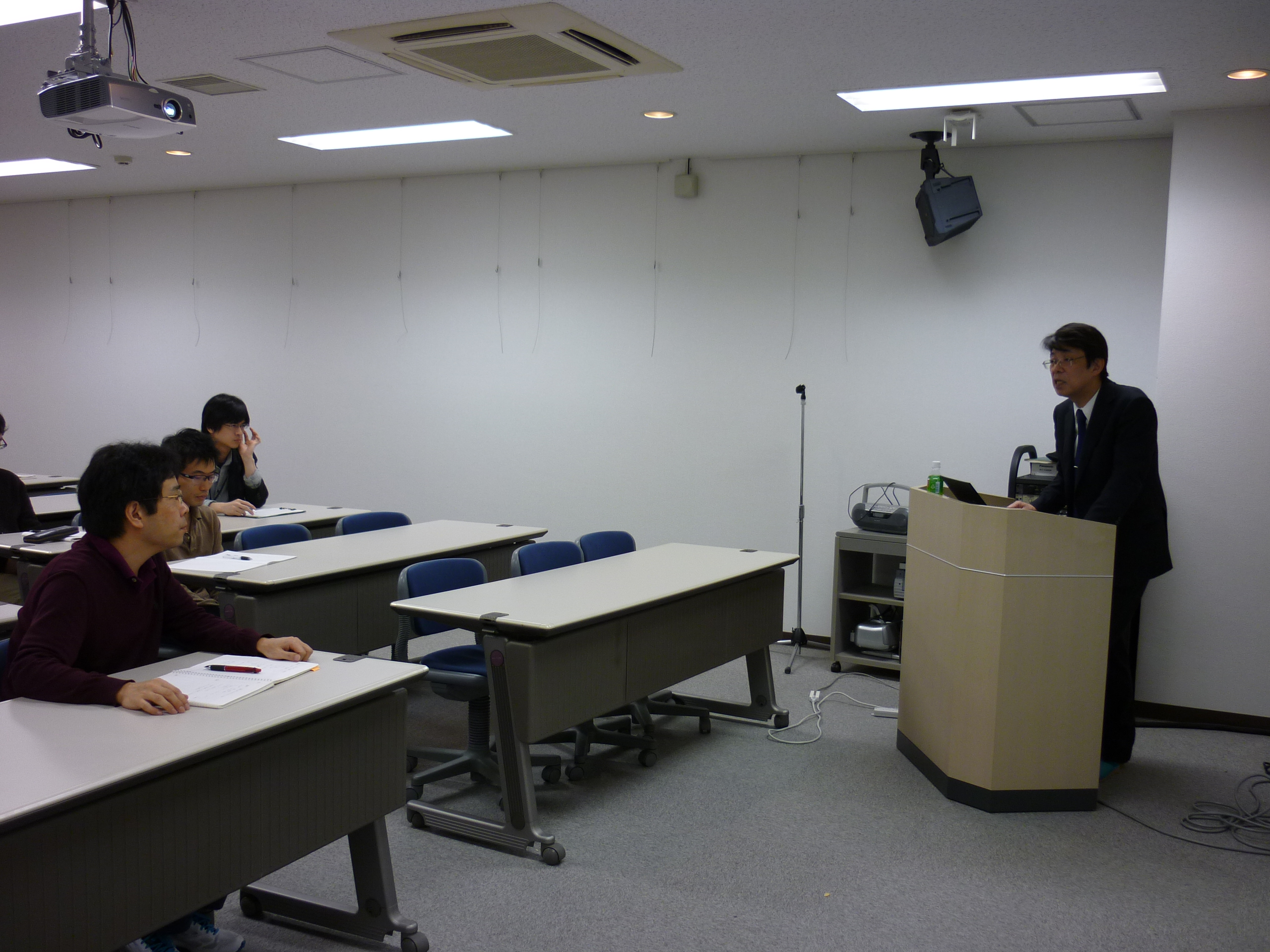 |
Date: 2015/3/16 PM 5:00~PM 6:00
Speaker: Dr.Yoshito KUMAGAI (Environmental Biology Laboratory, Faculty of Medicine, University of Tsukuba)
Title: Electrophiles-mediated modulation of redox signal transduction pathways
regulated by reactive sulfur species
Electrophiles react readily with protein thiolate ions, resulting in protein
adduct formations. For example, endogenous electrophiles covalently modify
sensor proteins with reactive thiols, leading to reduction of those activities,
thereby activating effector molecules (e.g., kinases, transcription factors).
We found that exogenous electrophiles in the environment activate redox-signal
transduction pathways through chemical modification of the sensor protein
thilate ions; however, such reactive chemicals disrupt these signaling,
resulting in occurrence of toxicity at higher concentrations. More interestingly,
environmental electrophiles-mediated these events are regulated by reactive
sulfur species through those sulfur adduct formations. In this lecture,
I will introduce our recent findings associated with modulation of redox-signal
transduction pathways mediated by environmental electrophiles and also
discuss biological significance of reactive sulfur species in repression
of the activation of signal transduction pathways and toxicity.
|
|
Date: 2015/3/16 PM 4:00~PM 5:00
Speaker: Dr.Takaaki AKAIKE(Department of Environmental Health Sciences and Molecular Toxicology Tohoku University Graduate School of Medicine )
Title: Paradigm-shifting protein modifications in redox signal regulation
Many organisms conduct high-level vital activities by energy metabolism that uses the chemical reactivity of molecular oxygen (oxidation-reduction: redox activity). The redox-based cellular signaling is now thought to be modulated by various protein effector molecules, as affected critically by reactive oxygen species via translational and post-translational pathways. Through this seminar, I will shed light on a previously unrecognized protein modification, i.e., protein S-polythiolation, as a paradigm-shifting discovery evolving from the changing concept of redox biology, as well as redox pathology known as oxidative stress.
|
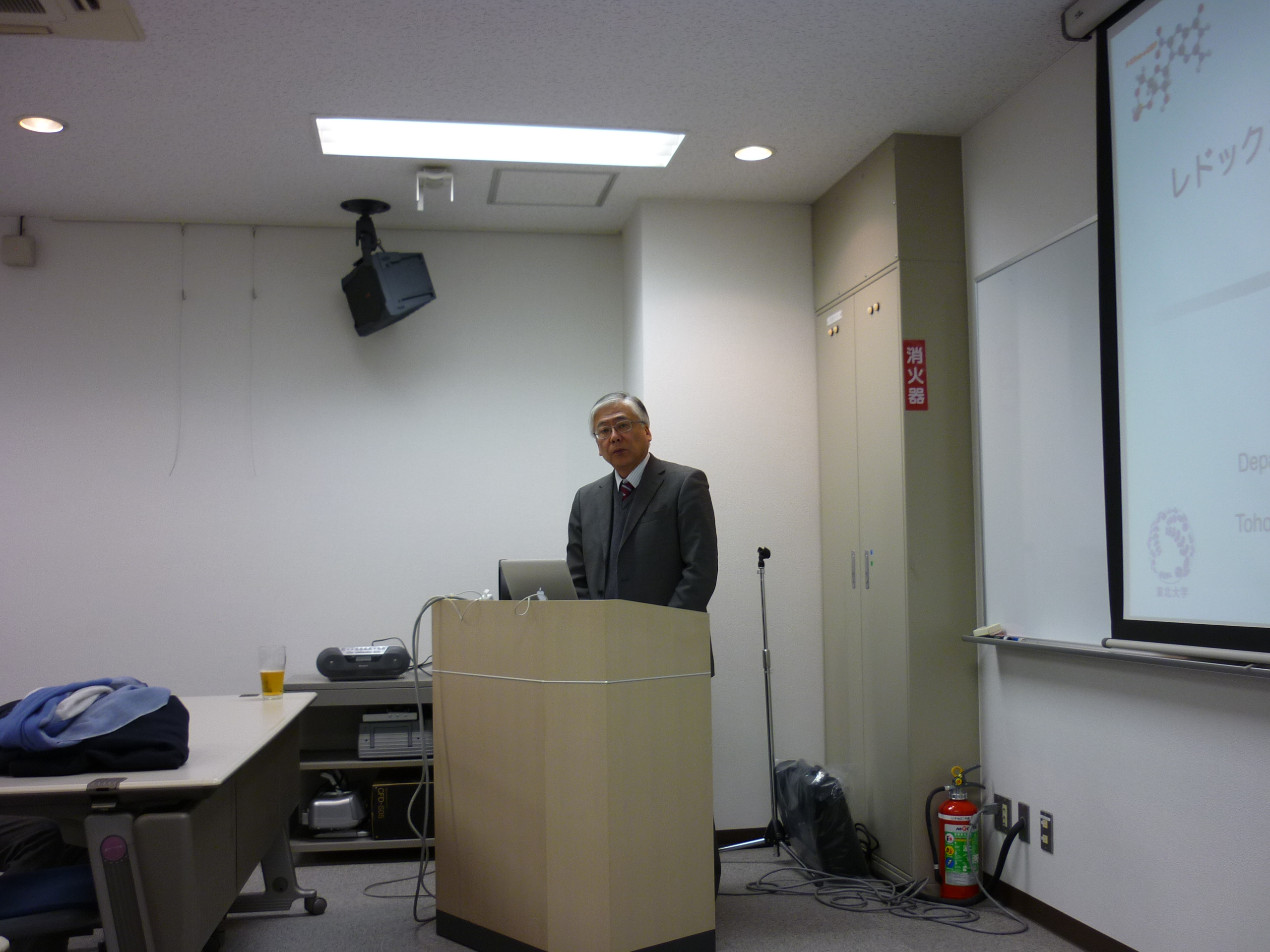 |
Date: 2015/2/24 AM 10:00~AM11:00
Speaker: Dr.Tomoya ITO(Laboratory of Molecular Biology (Mori laboratory),
Department of Synthetic and Biological Chemistry, Graduate School of Engineering, Kyoto University)
Title : Identification of a novel protein-coding gene OGU1 regulatingintracellular
transport of TRPC channels
Thousands of transcribed long RNAs have been discovered in mammalian intergenic
region. Although recent study indicates that these intergenic transcripts
are predicted to be long noncoding RNA (lncRNA) gene candidates, biologically
functional entities of these most gene candidates remain elusive. We revealed
that lncRNA locus OGU1 (osteogenesis up-regulating transcript 1) is indeed
endogenously translated into a small protein that activates TRP (transient
receptor potential) channels. Moreover, our present study suggests that
OGU1 recruits TRPC channels to the cell surface by regulating unconventional
intracellular trafficking.
|
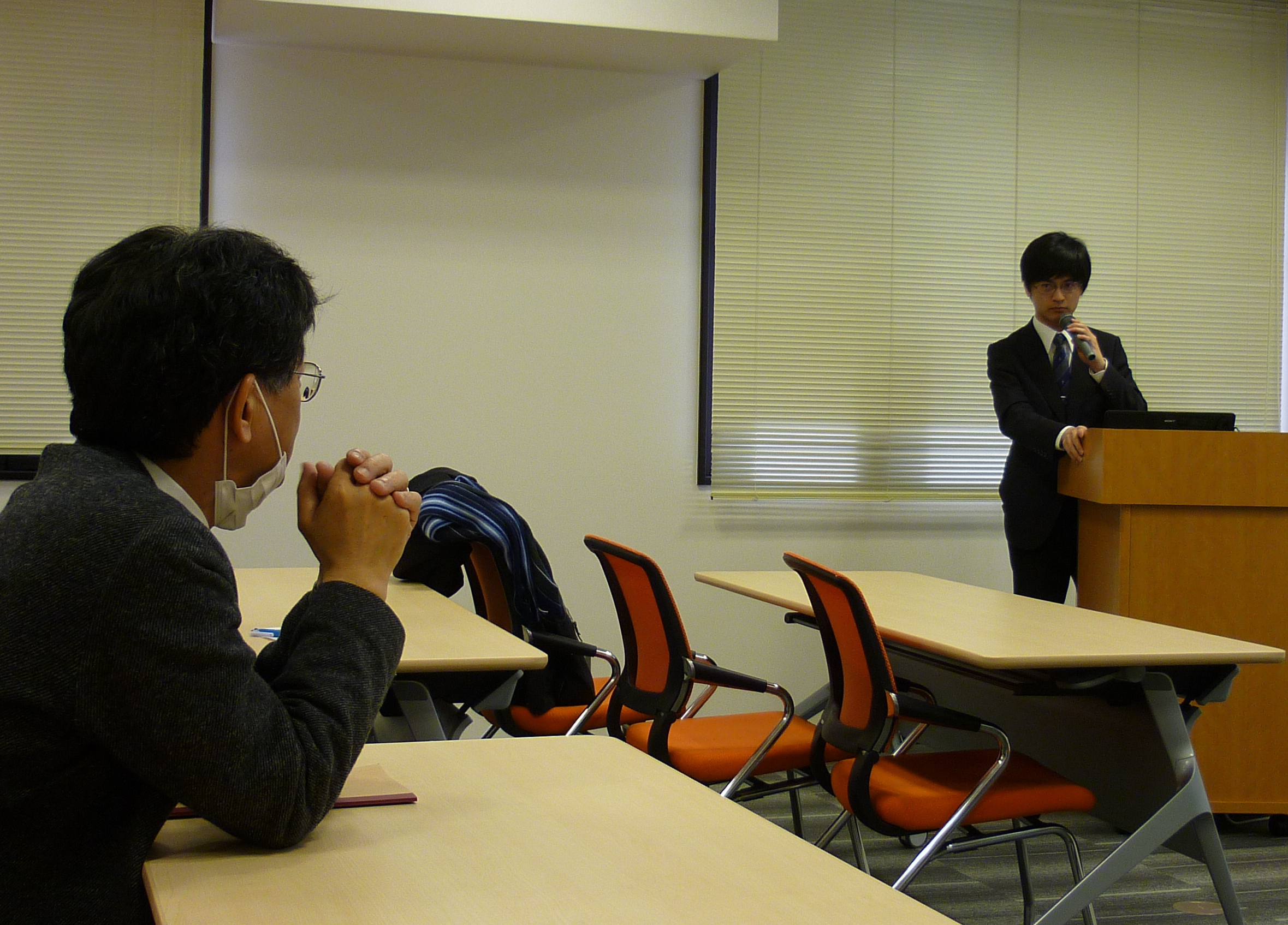 |
Date: 2015/1/15 PM 2:00~PM 3:00
Speaker: Dr.Hiroyuki KOBAYASHI(Molecular Pharmacology Unit (Michel Bouvier), Institut de Recherche en
Immunologie et en Cancérologie, Université d e Montréal)
Title: GPCR interacting proteins and signaling diversity – Studies based
on BRET assay
G protein-coupled receptor (GPCR) is one of the largest families of proteins
transducing extracellular signals through cellu lar membrane. Although
GPCRs are described as ‘ON’ or ‘OFF’ switches in the classical two state
model, recent studies revealed that one GPCR can activate many GPCR-dependent/independent
signaling pathways simultaneously, but limit the pathway s it activates
depending on the functional states determined by ligand binding and/or
signalosome formation. This concept th at GPCR can change the downstream
signal dynamically depending on the receptor microenvironment, is called
“Ligand-biased s ignaling”, and creates new paradigm in the receptor research
and drug design. We are aiming at elucidating the structural d eterminants
of this GPCR signaling diversity, and developed assay tools based on BRET,
bioluminescence resonance energy tran sfer, techniques.
|
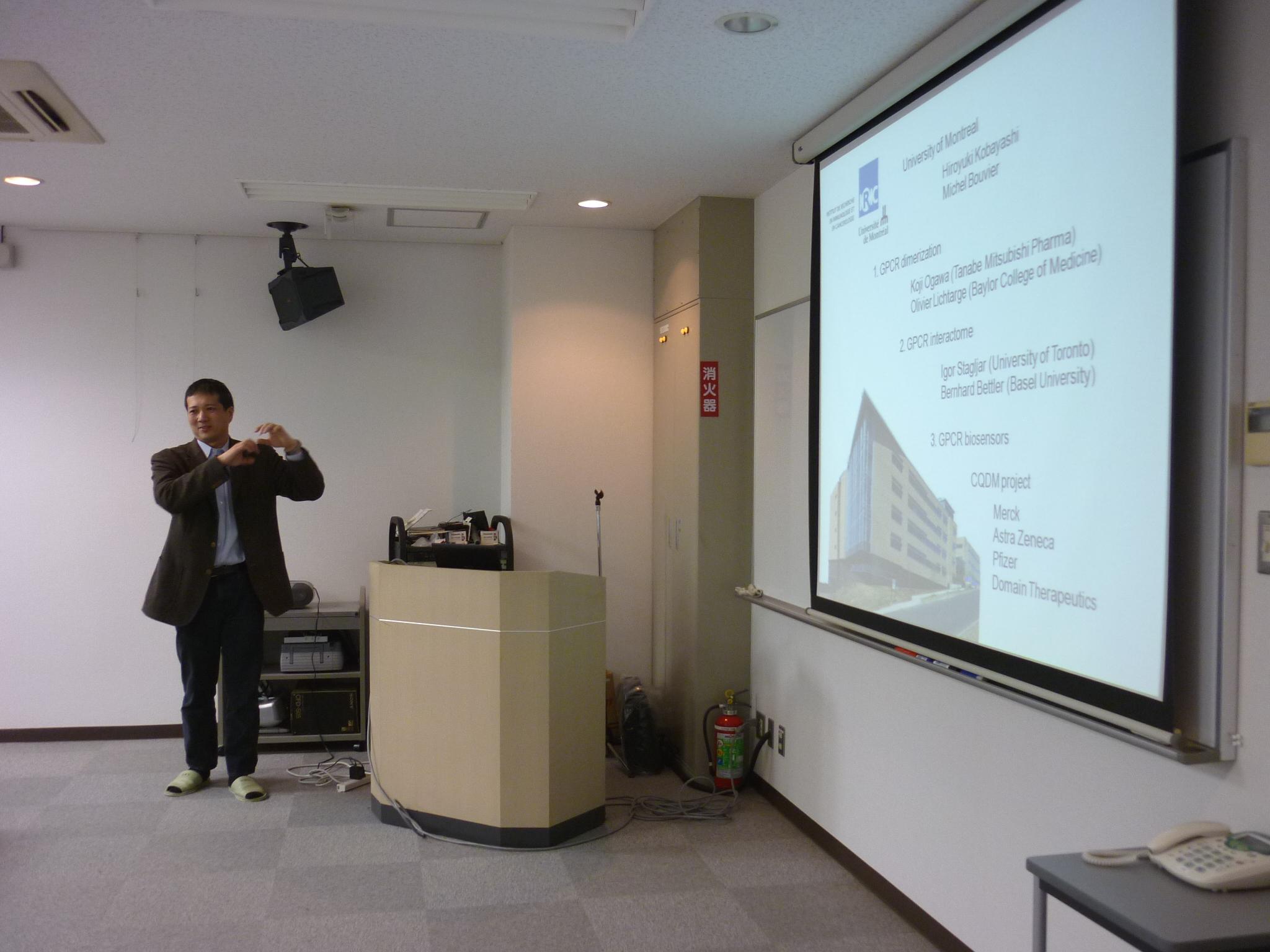 |
|
| |
2014
|
Date: 2014/12/22 PM 5:00~PM 6:00
Speaker: Dr. Supachoke Mangmool(Department of Pharmacology, Faculty of Pharmacy, Mahidol University,
Thailand)
Title: Sustained β-adrenergic receptor stimulation mediates cardiac insulin
resistance in a PKA-dependent manner
Insulin resistance is a condition in which there are defects in the
insulin actions to induce tissue glucose uptake. Overstimulation of
β-adrenergic receptors (βARs) leads to the development of heart failure
and is associated with the pathogenesis of insulin resistance in the
heart. However, the mechanisms by which βARs overstimulation affect
insulin resistance in the heart are incompletely understood. We examine
the mechanism for insulin resistance regulated by overstimulation of βARs.
In this study, we show that sustained βAR stimulation with isoproterenol
(ISO) showed the inhibition of insulin-induce glucose uptake and glucose
transporter-4 (GLUT4) expression is mediated by the β2AR subtype in
cardiomyocytes and heart tissue. Moreover, ISO stimulation attenuated
insulin-induced GLUT4 translocation in β2AR-overexpressing HEK-293
cells. Overstimulation of βARs plays a key role in the enhancement of
insulin resistance in the heart through cyclic adenosine monophosphate
(cAMP)-dependent and protein kinase A (PKA)-dependent pathways.
Treatment with β-blockers is able to antagonize the action of
ISO-mediated insulin resistance in the heart.
The essential role for βARs and identification of the molecular
mechanism of βARs on the induction of insulin resistance in the heart
advances our understanding, leading to a new therapeutic target for
heart diseases.
|
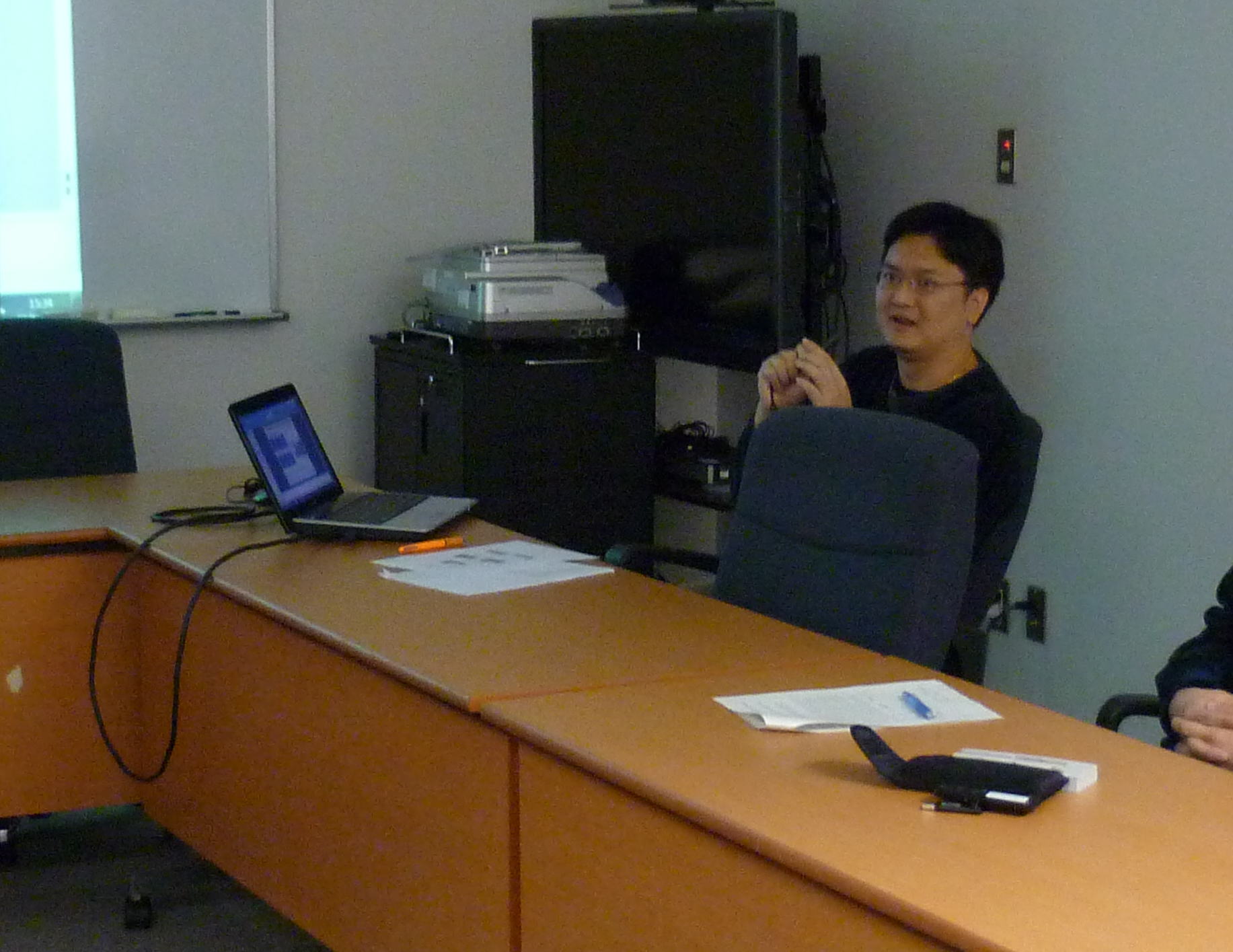 |
Date: 2014/10/28 PM 5:30~PM 6:30
Speaker: Prof. Hirofumi KAI(Dept. of Metabolic Medicine, Graduate School of Medical Sciences, Kumamoto
University)
Title:Beneficial effects and their molecular mechanisms of specific pulse
width mild electrical stress as physical medicine
Electrical current at physiological strength has been used as folk medicine
and applied as a therapeutic approach for various diseases.Recently, we
have shown that specific pulse width mild electrical stress (MES : duration
: 0.1 millisecond, 55 pulse per second, voltage : 1~2 V/cm) has positive
impact on organisms. We have shown that together with heat shock, which
elevated the level of heat shock protein 72 (Hsp72), MES attenuated hepatic
ischemia/reperfusion injury in mice, ameliorated the diabetic phenotype
and protected pancreatic β-cells in diabetes mouse model, reduced inflammatory
markers in healthy male subjects, and decreased the proteinuria and renal
inflammation in Alport syndrome mouse model. In the Alport model, MES was
shown to activate not only PI(3)K-Akt pathway but also the p38 MAPK signaling
pathway. Recently, we have found that MES activated p53, a tumor suppressor
known for its cellular protective functions via a network of signaling
pathways, leading to G2 phase arrest, and that MES affected LKB1-AMPK signaling,
which in turn increases stress resistance and suppresses fat accumulation
in C. elegans. These findings add to our growing knowledge of the underlying
mechanisms of the effects of optimized mild electrical stimulation as physical
medicine.
|
 |
Date: 2014/9/12 PM 4:00~PM 5:00
Speaker: Dr.Yasunori KANAHO(Dept. of Physiological Chemistry, Faculty of Medicine, Univ. of Tsukuba)
Title:Unexpected physiological significance of the small G protein Arf6
The small G protein Arf6 functions as a molecular switch in various signal transduction systems and regulates membrane recycling. In 1999, we found a very interesting novel function of Arf6 that this molecule regulates membrane dynamics through the activation of the lipid kinase PIP5K. Thereafter, we have been focusing to analyze the physiological functions of Arf6 and its involvement in pathophysiology at the whole animal level. In this seminar I show our recent progress about pathophysiological functions of Arf6.
|
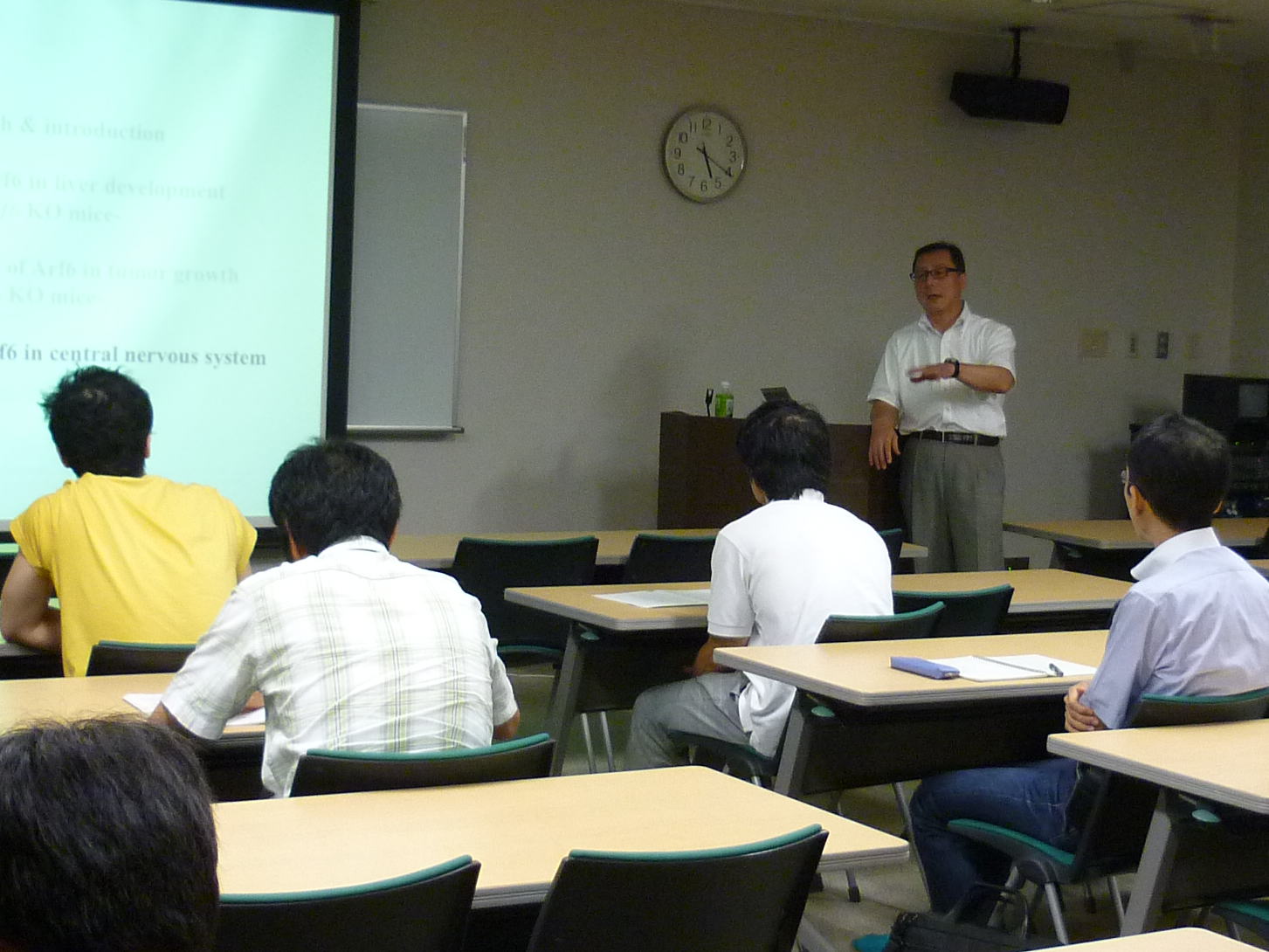 |
Date: 2014/9/12 PM 5:15~PM 6:15
Speaker: Dr.Shinichi HOSHINO(Graduate School of Pharmaceutical Sciences, Nagoya City University)
Title:Mechanism of mRNA decay and regulation of gene expression
mRNA decay plays a pivotal role in gene expression. Shortening
of the 3’poly(A) tail, called deadenylation, is the first and the late-limiting
step in the decay of general mRNA. We have previously shown
that translation termination acts as a trigger of mRNA decay and proposed
a model for the translation termination-coupled mRNA decay: after translation
termination, the termination factor eRF3 dissociates from mRNA, which triggers
recruitment of the deadenylases, Pan2-Pan3 and Caf1-Ccr4, to initiate mRNA
decay. In this seminar, I will talk about novel regulatory mechanisms
of gene expression, which target deadenylatio.
|
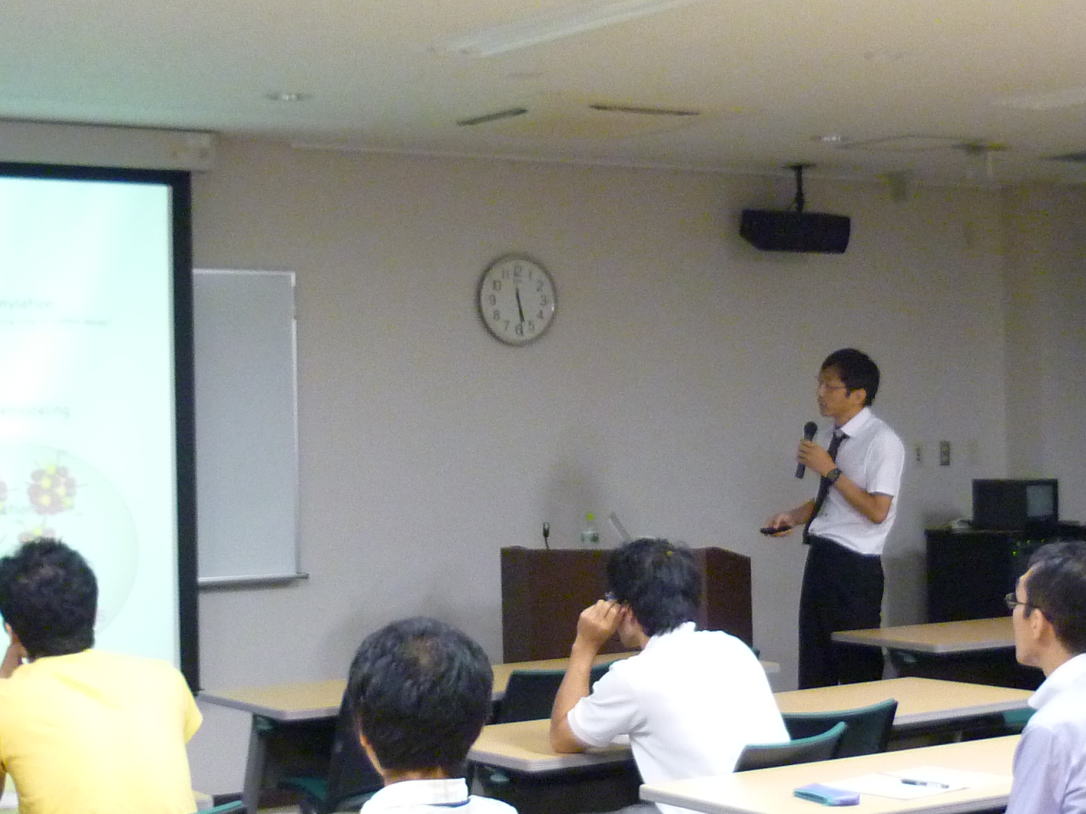 |
Date: 2014/6/23 PM 4:00~PM 5:00
Speaker: Dr. Gentaro IRIBE(Cardiovascular Physiology, Okayama Univ.)
Title:Physiological implications of mechanosensitive response of mitochondria
in cardiomyocytes
Myocardium contracts against ventricular wall stretch. Myocardial contraction
requires ATP that is produced by mitochondrial electron transport system.
Mitochondrial ATP production process is also known as one of the sources
of reactive oxygen species (ROS), which are toxic molecules, but also important
physiological regulators of intracellular signaling pathways. We previously
found that myocardial stretch increases Ca2+ spark, which is local and spontaneous Ca2+ releasing event from sarcoplasmic reticulum. Our recent findings indicate
that stretch-induced increase in mitochondrial ROS production is associated
with these responses.
|
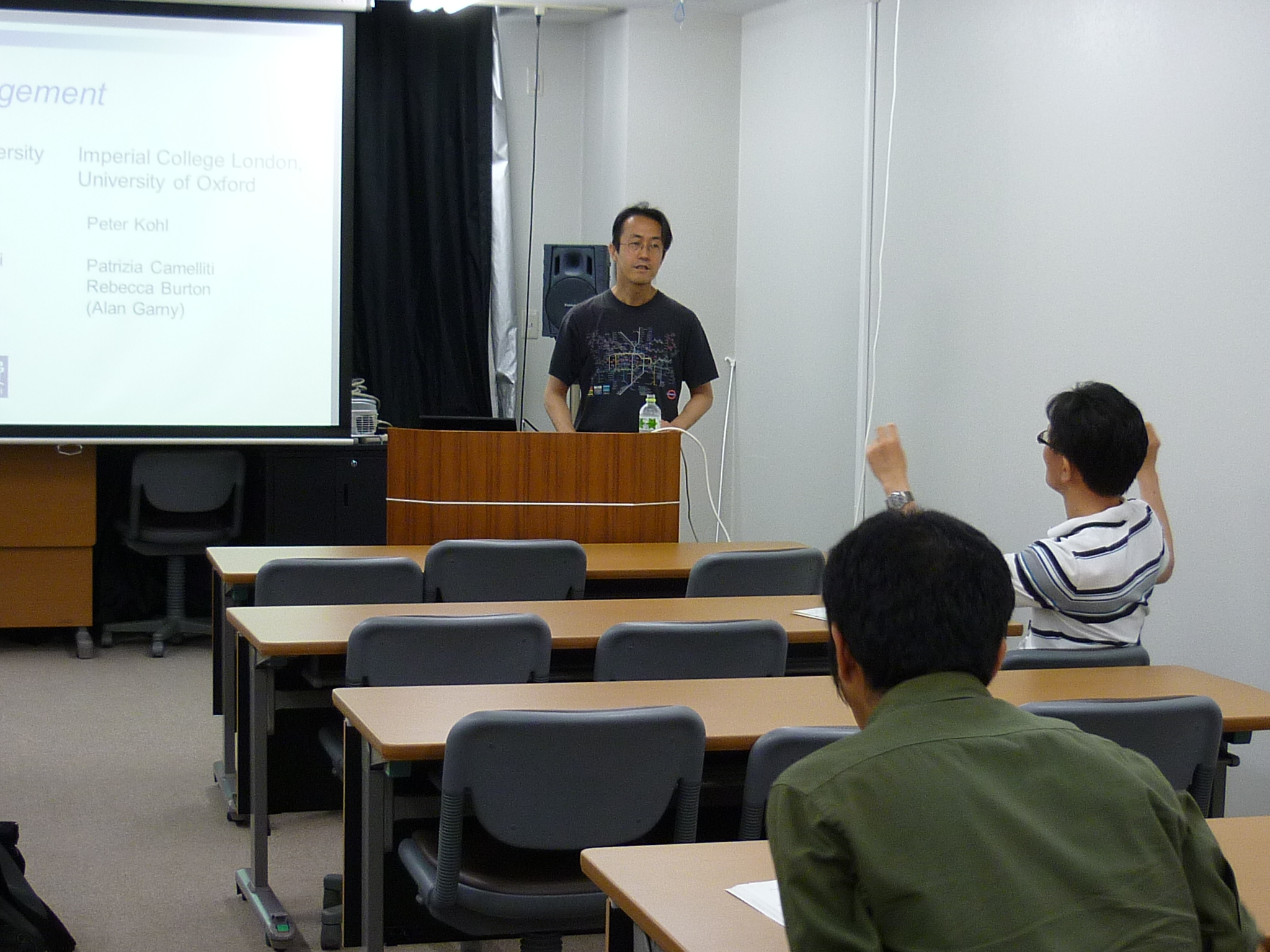 |
Date: 2014/5/20 PM 2:00~PM 3:00
Speaker: Dr. Hidetoshi SAITOH(Dept of Molecular and System Pharmacology, Kyusyu Univ.)
Title:Role of P2Y purinergic receptors in microglia
Microglia are constantly surveying the brain parenchyma. Incidents in the
brain rapidly activate microglia and activated microglia induce chemotaxis,
phagocytosis and inflammatory responses. Extracellular nucleotides are
signaling molecules used by microglia to sense adverse physiological conditions.
They act through several purinoceptors in microglia. We have found that
P2Y6 receptor enhances microglial macropinocytosis which regulated by protein
kinase D, and P2Y12 receptor elicit transient intracellular calcium increases which leads to the de novo production of several chemokines. Each findings are now associated with amyloid beta uptake by microglia and microglial P2Y12 receptor mediated development of neuropathic pain.
|
|
Date:2014/2/28 PM 1:30~PM 2:30
Speaker: Dr.Kenji TAGO (Dept of Biochem, Div of Structural Biochem, Jichi Med Univ)
Title:Functional analysis of atypical Ras family protein in oncogenic signal
A small GTPase κB-Ras was identified as a Ras family protein inhibiting a transcription factor NF-κB. We previously clarified the molecular mechanism how κB-Ras inhibits the NF-κB activation. In the current study, we found that κB-Ras harbors the critical roles in Ras (G12V)-caused oncogenic signals. Furthermore, we purified κB-Ras-containing protein complexes, and identified novel κB-Ras binding proteins including TRB3, SmgGDS, DDB1, NONO. Our study suggests that κB-Ras could contribute to the oncogenic signaling pathway through the interaction with these binding proteins.
|
|
Date:2014/1/7 PM 3:00~PM 4:00
Speaker: Takuro Tomita (Assistant Professor, Department of Drug Discovery and Evolution, Graduate
School of Pharmaceutical Sciences, Kyushu University)
Title:Receptor-activated cation channels and thier physiological importances
|
|
Date:2014/1/7 PM 4:00~PM 5:00
Speaker: Akiyuki Nishimura (Postdoc Fellow, Department of Molecular Medicine, Cornell University,
USA)
Title:Identification of novel prenyl-parmitoyl modification of Cdc42 and
its functional role
|
|
|
|
